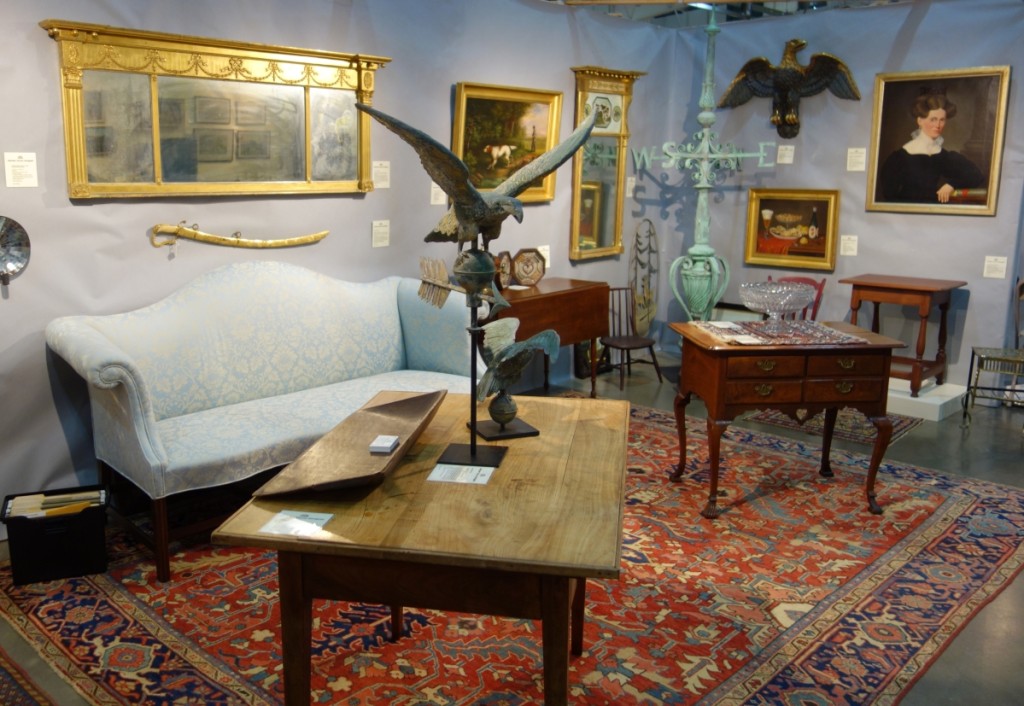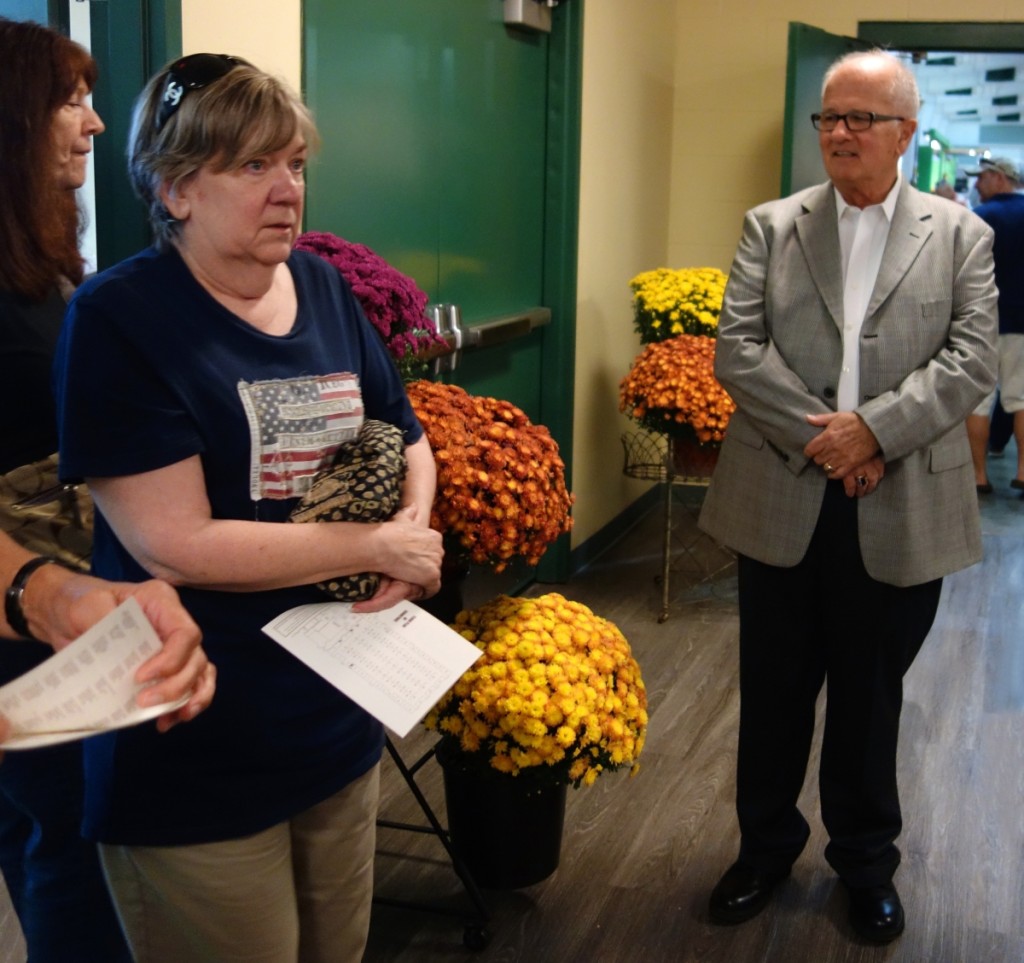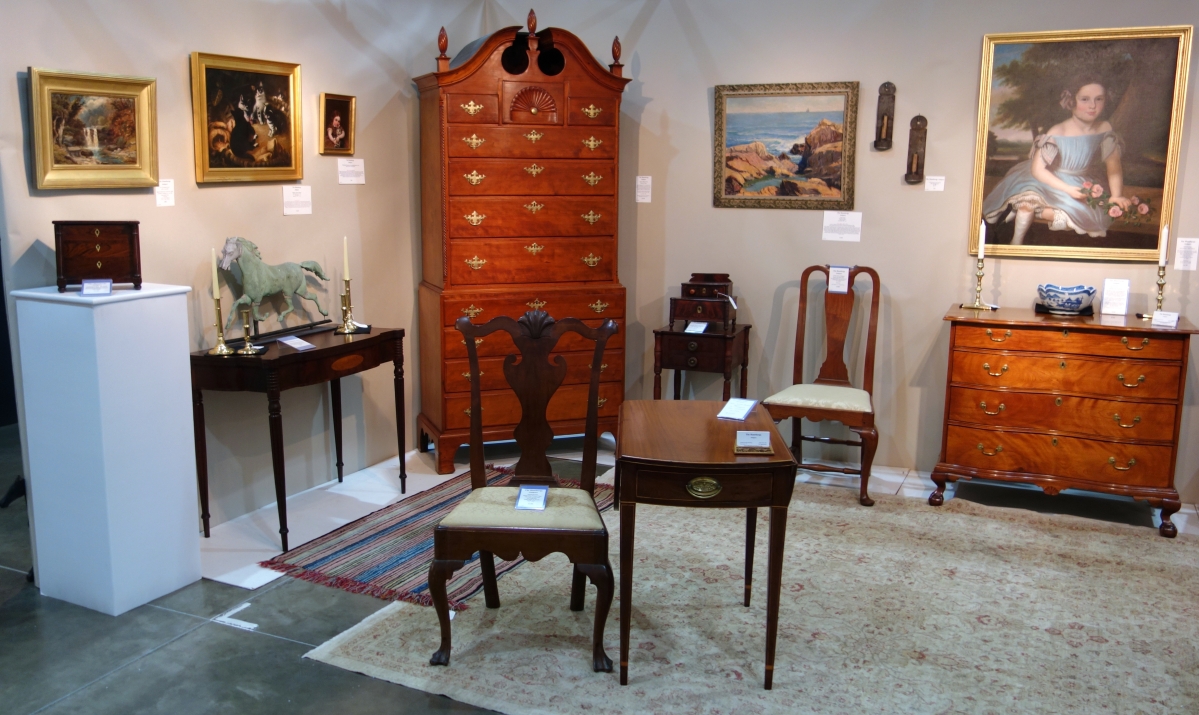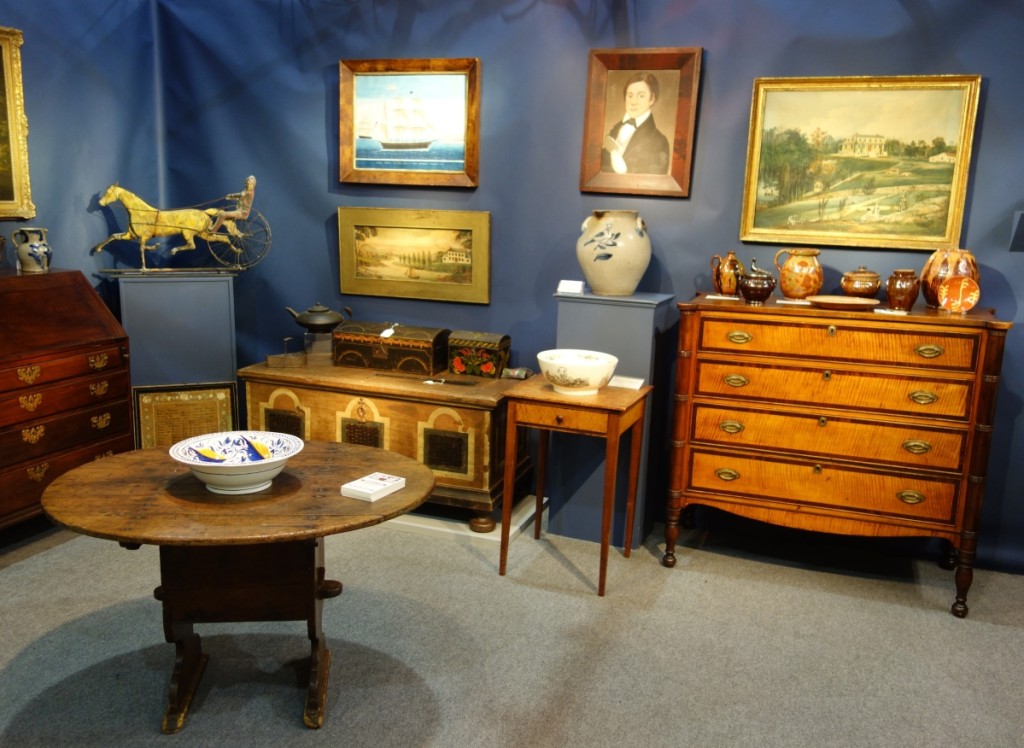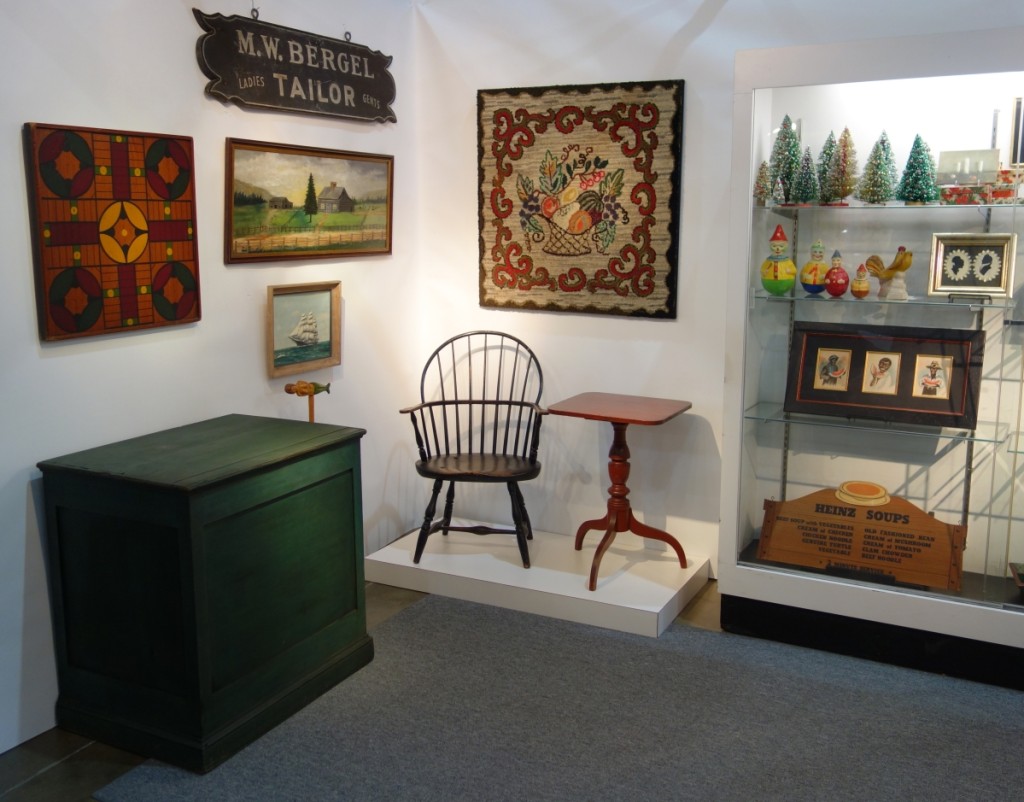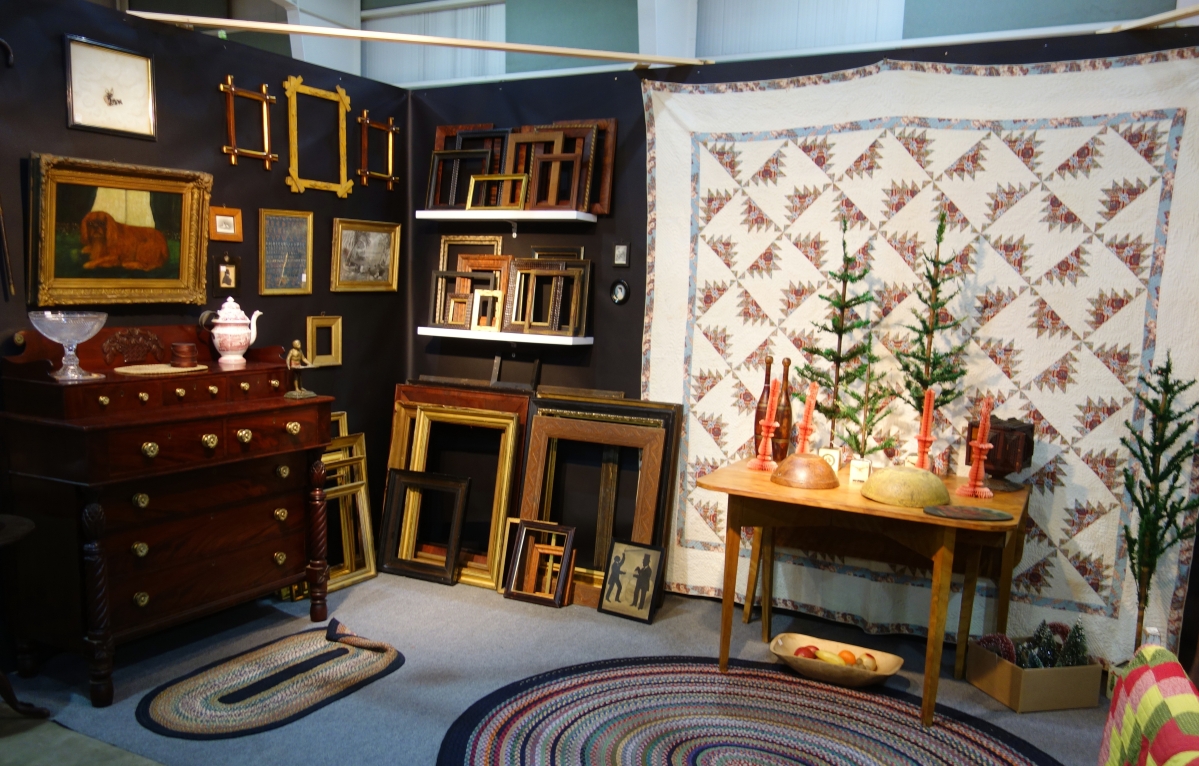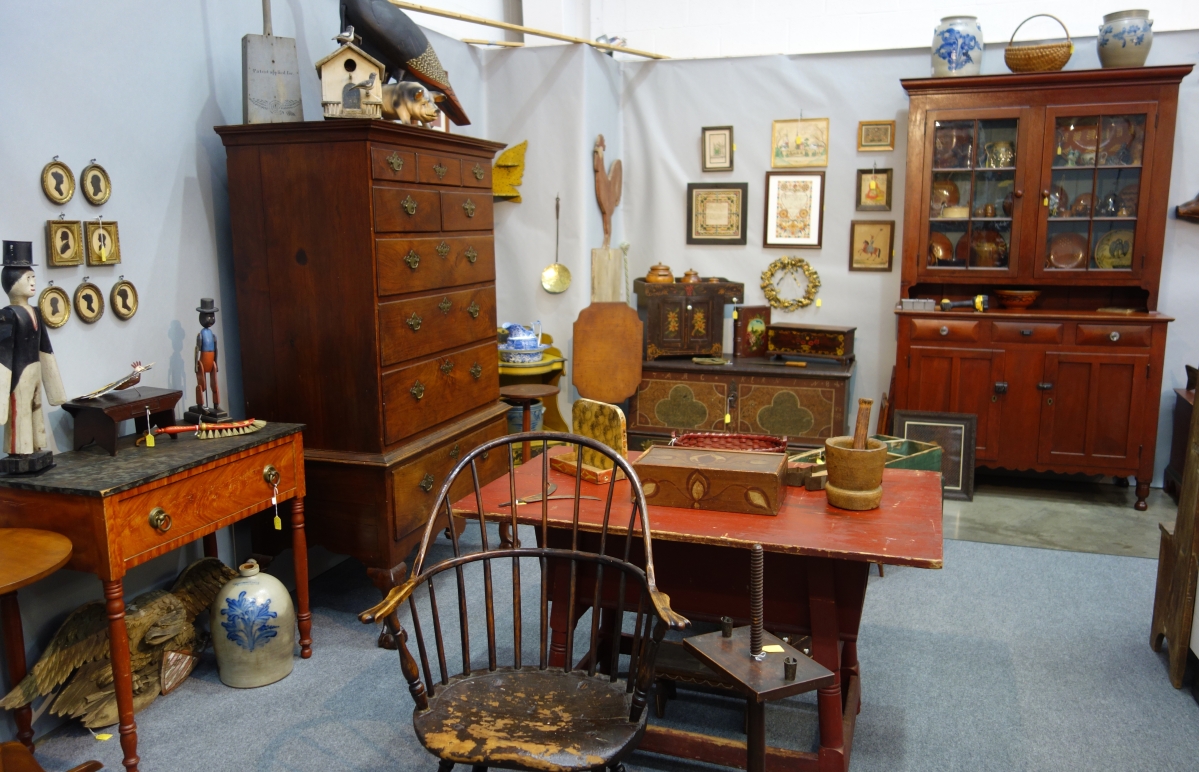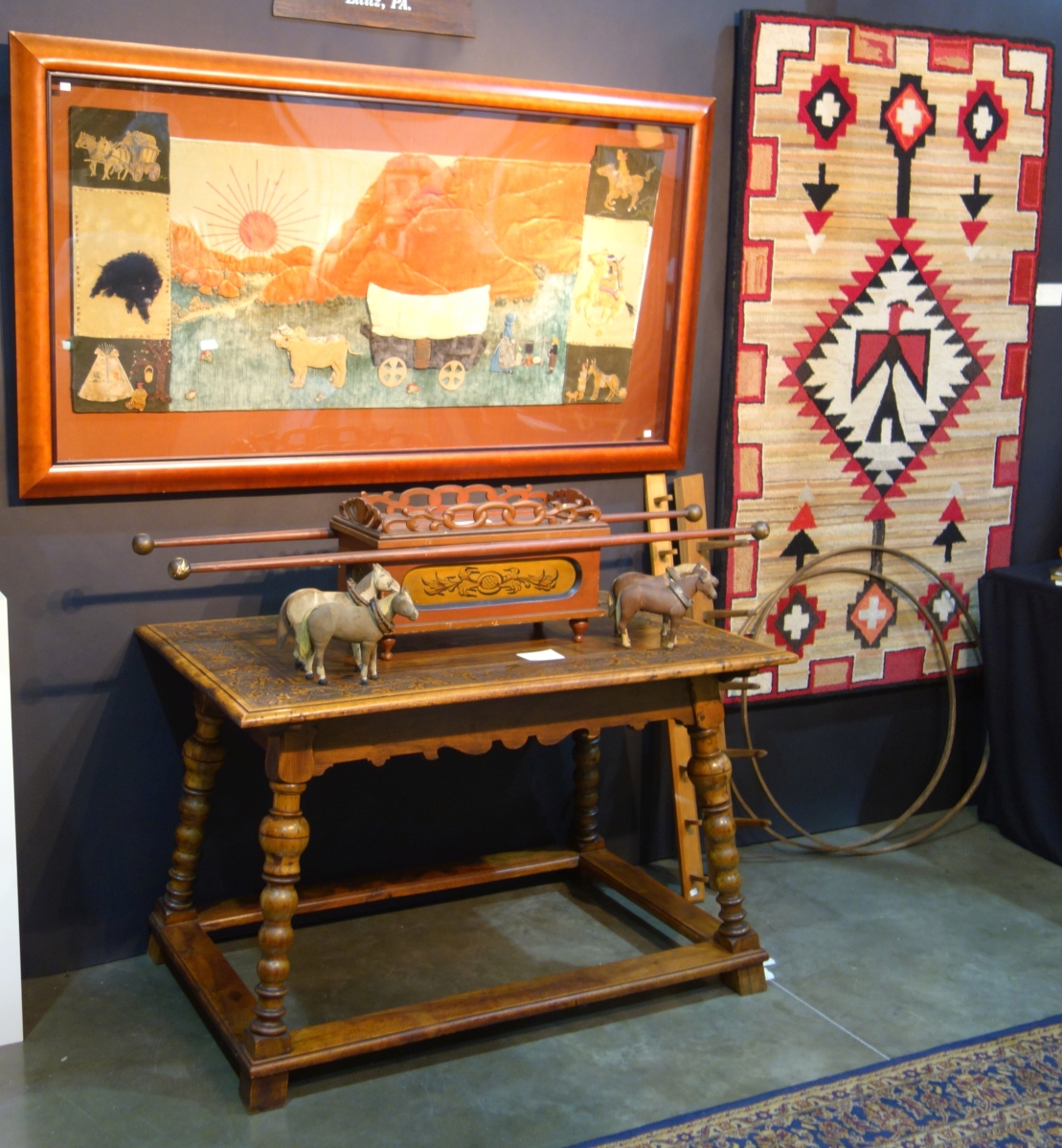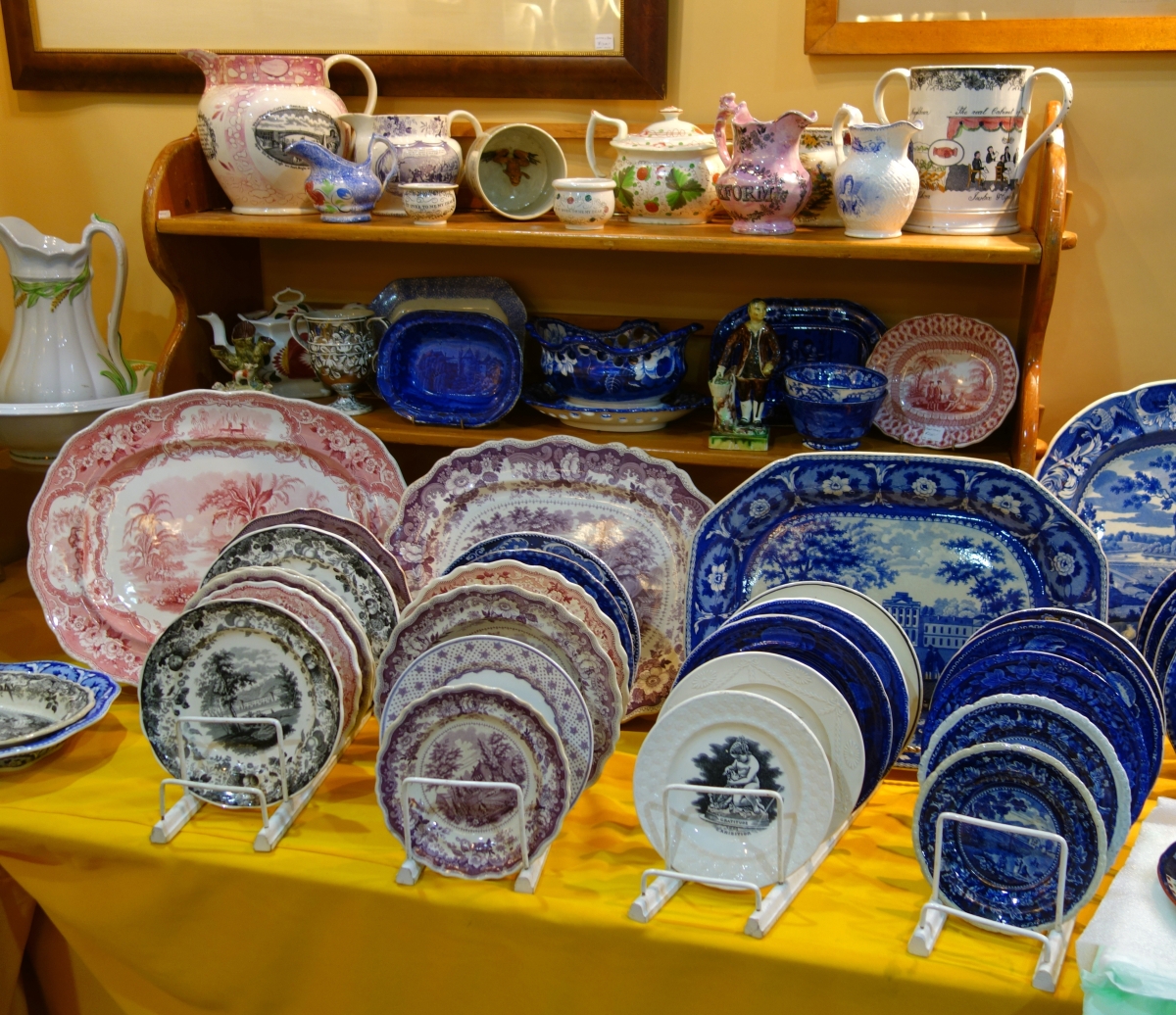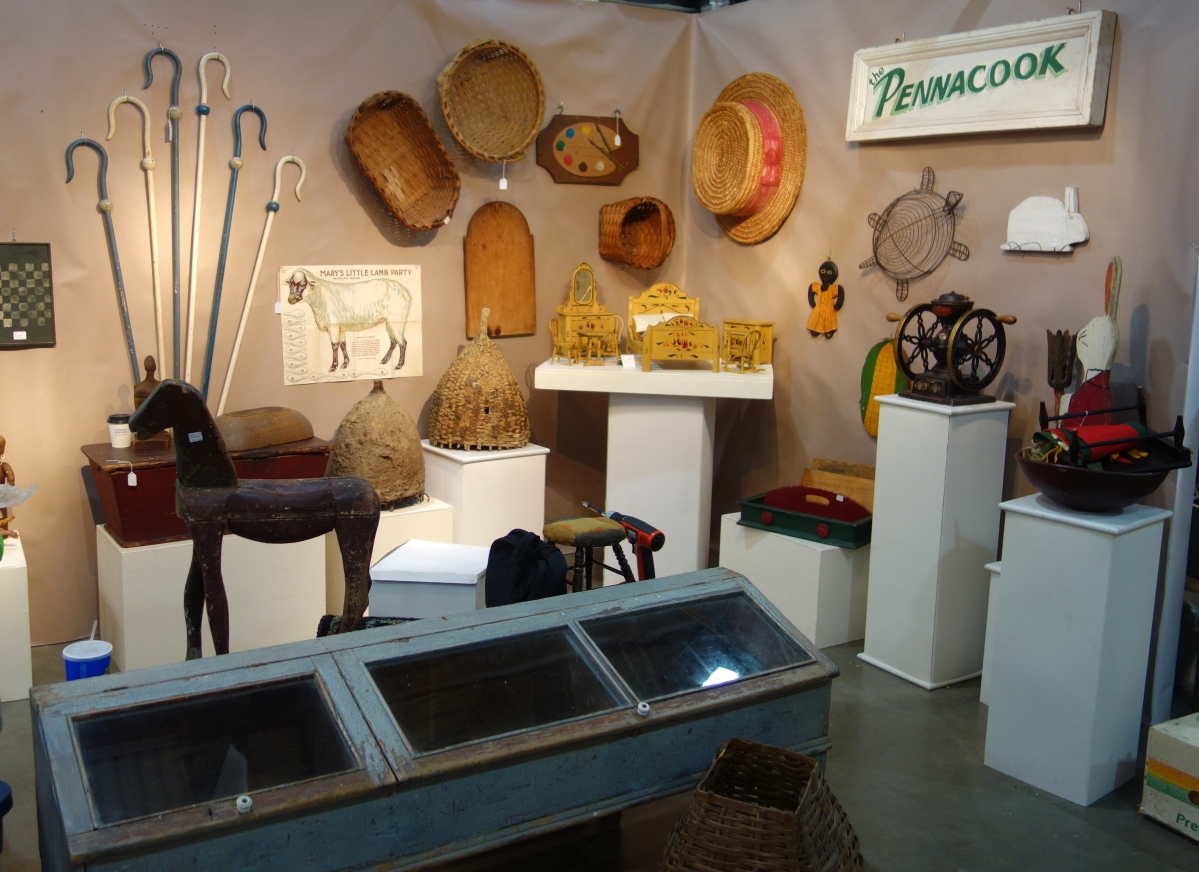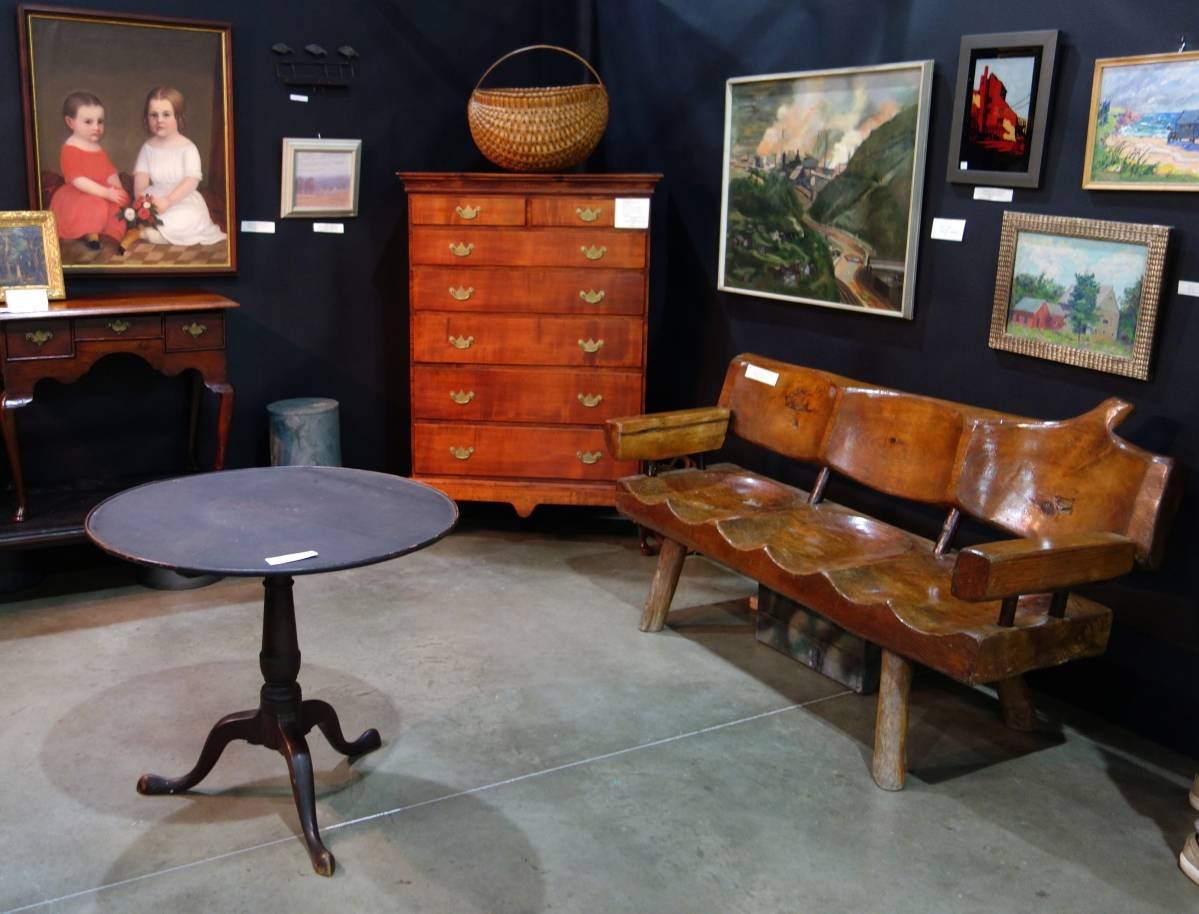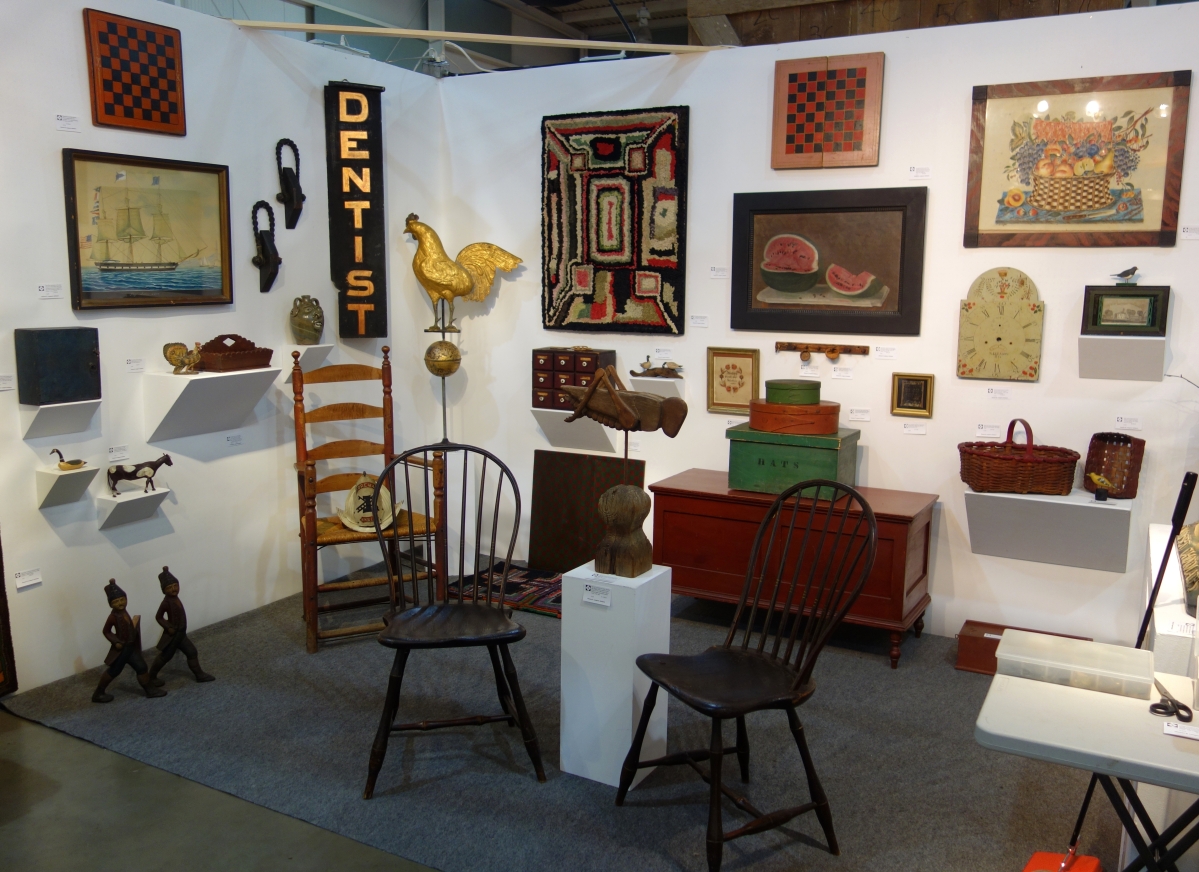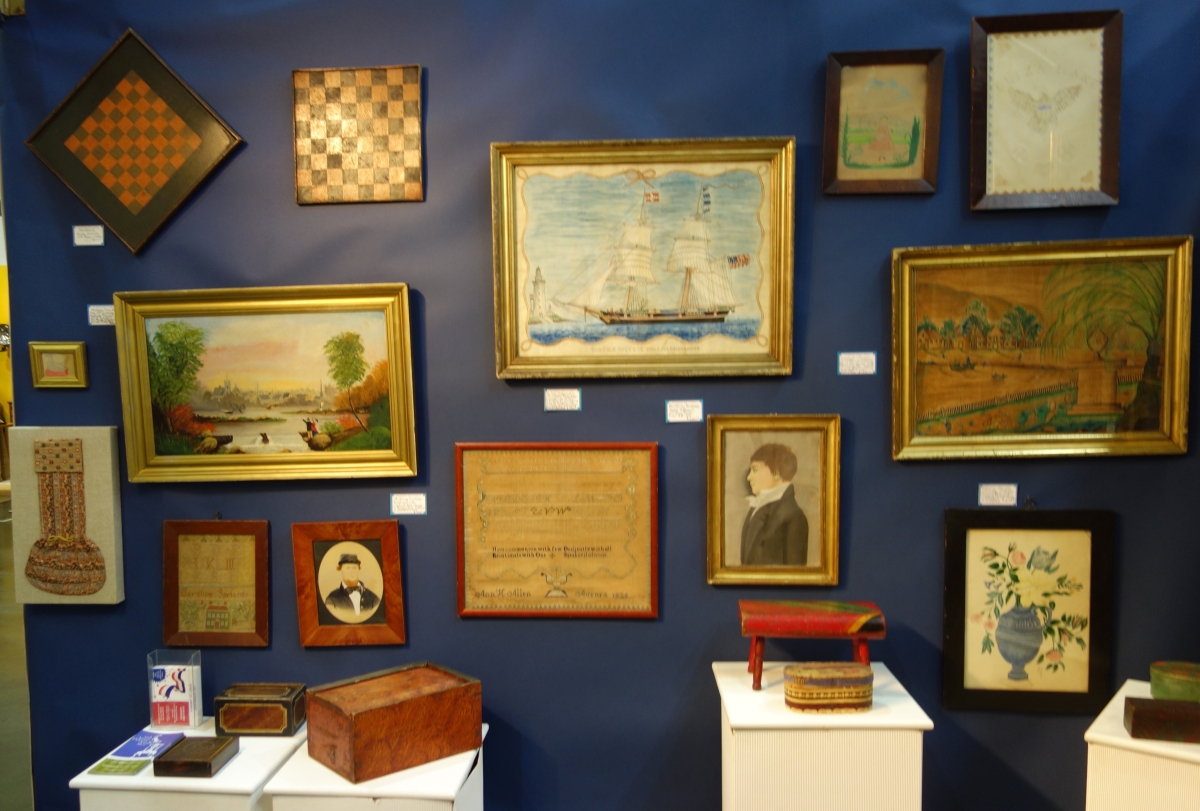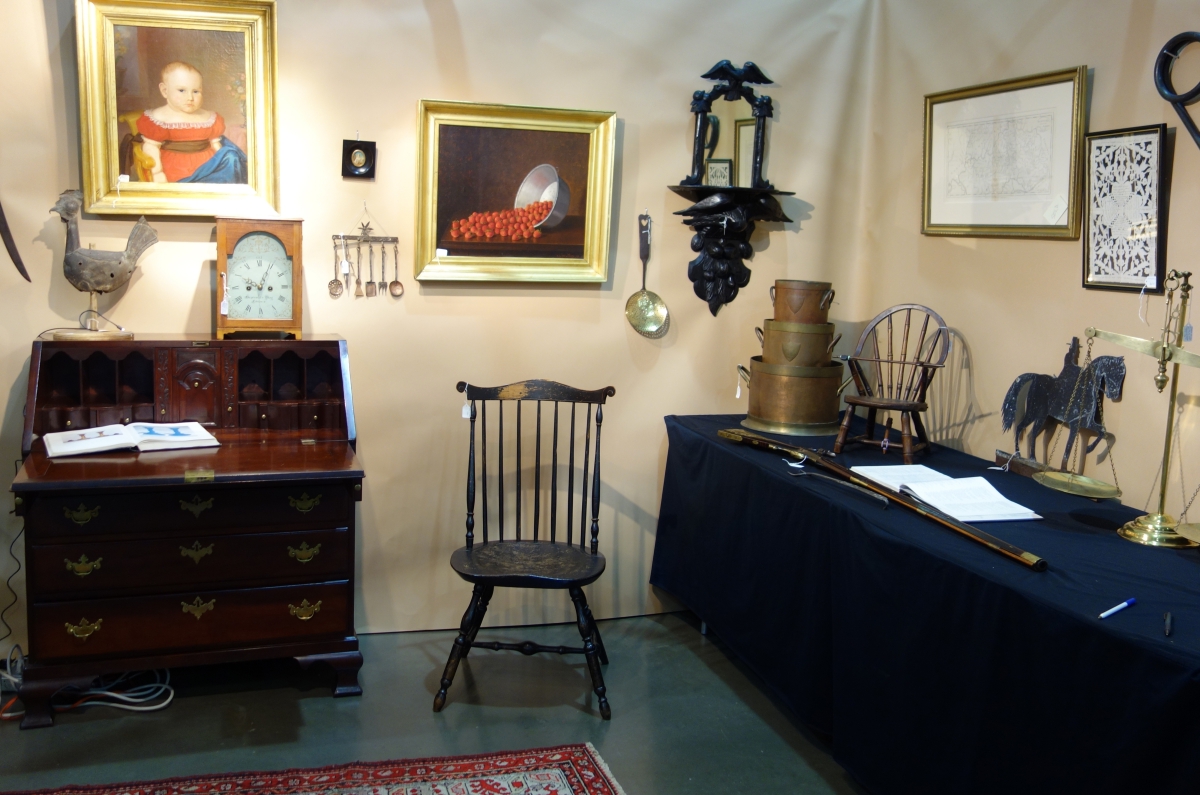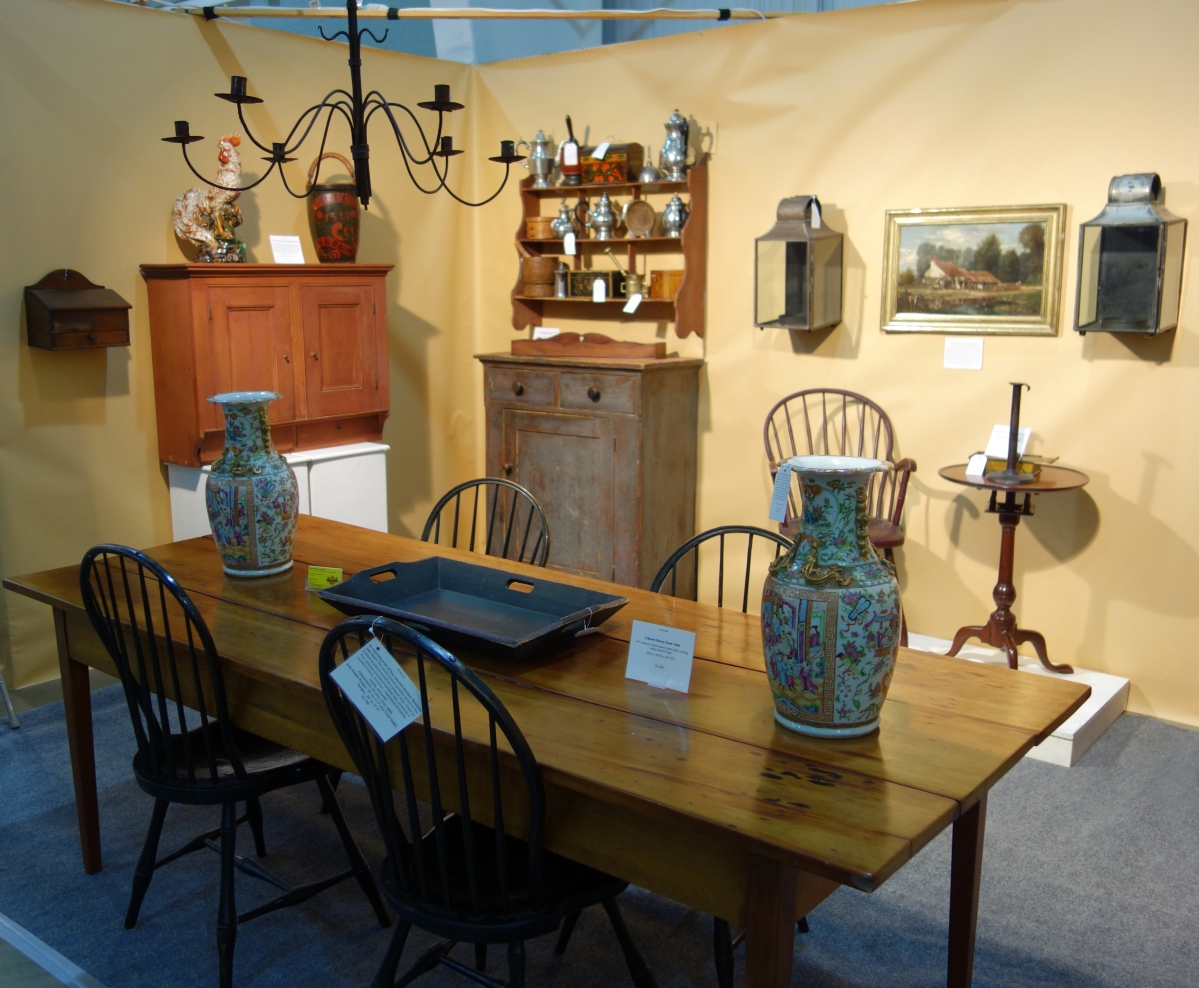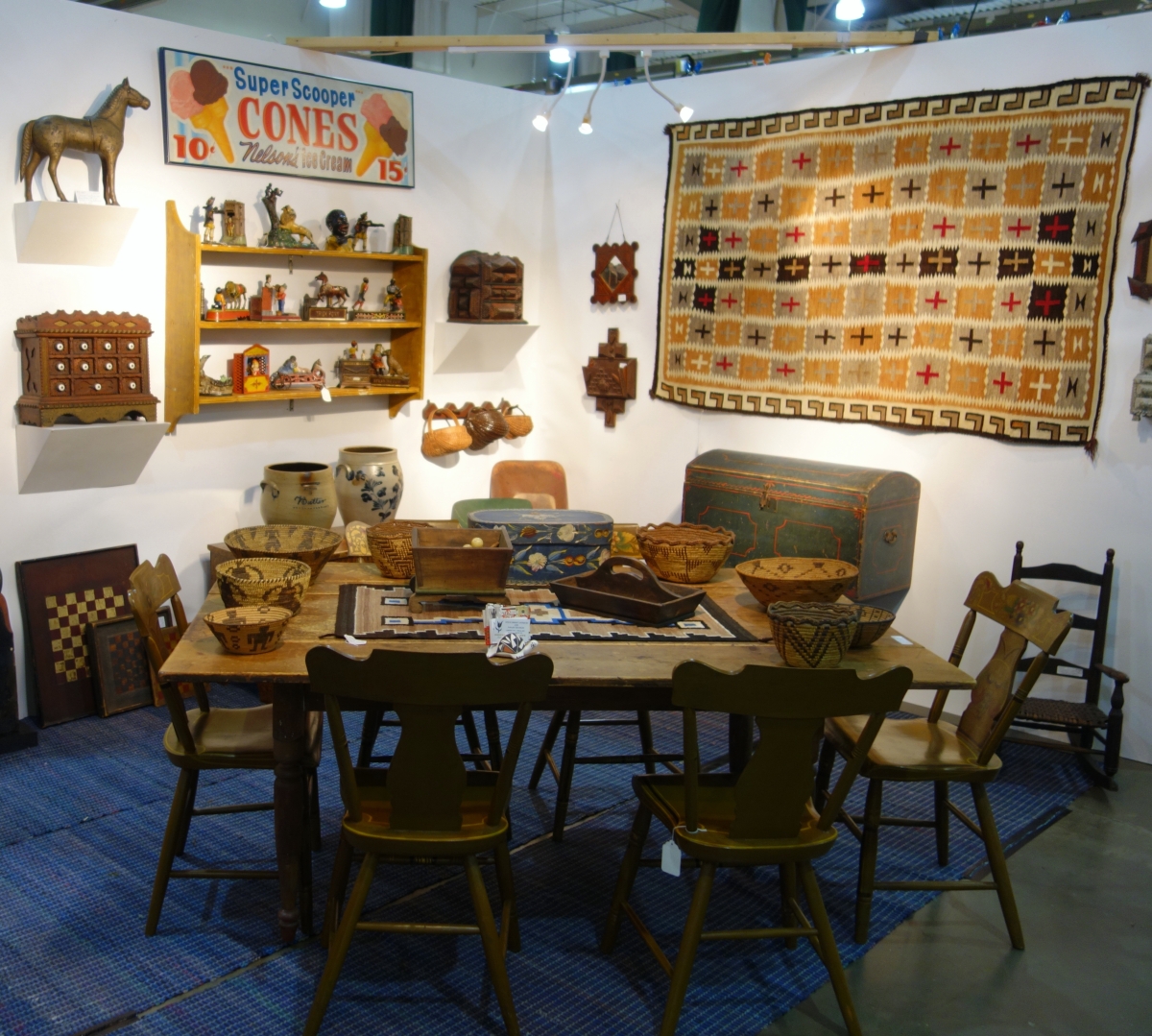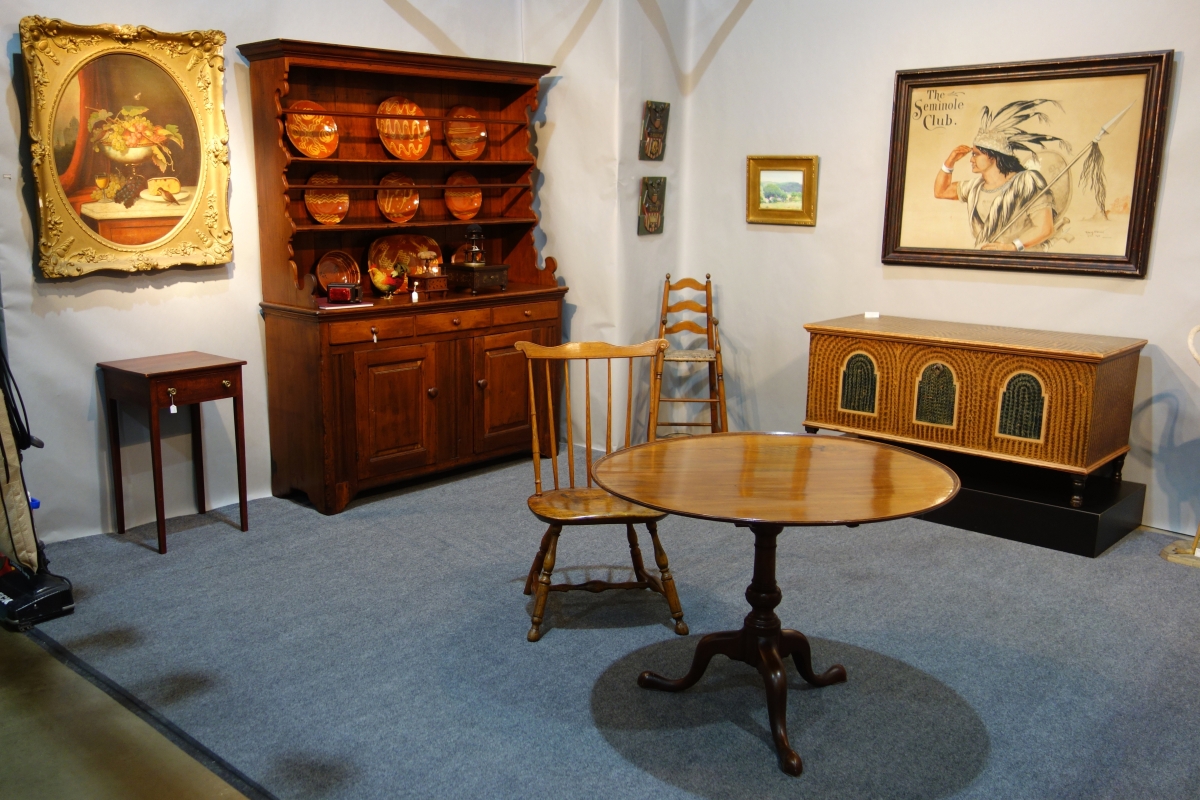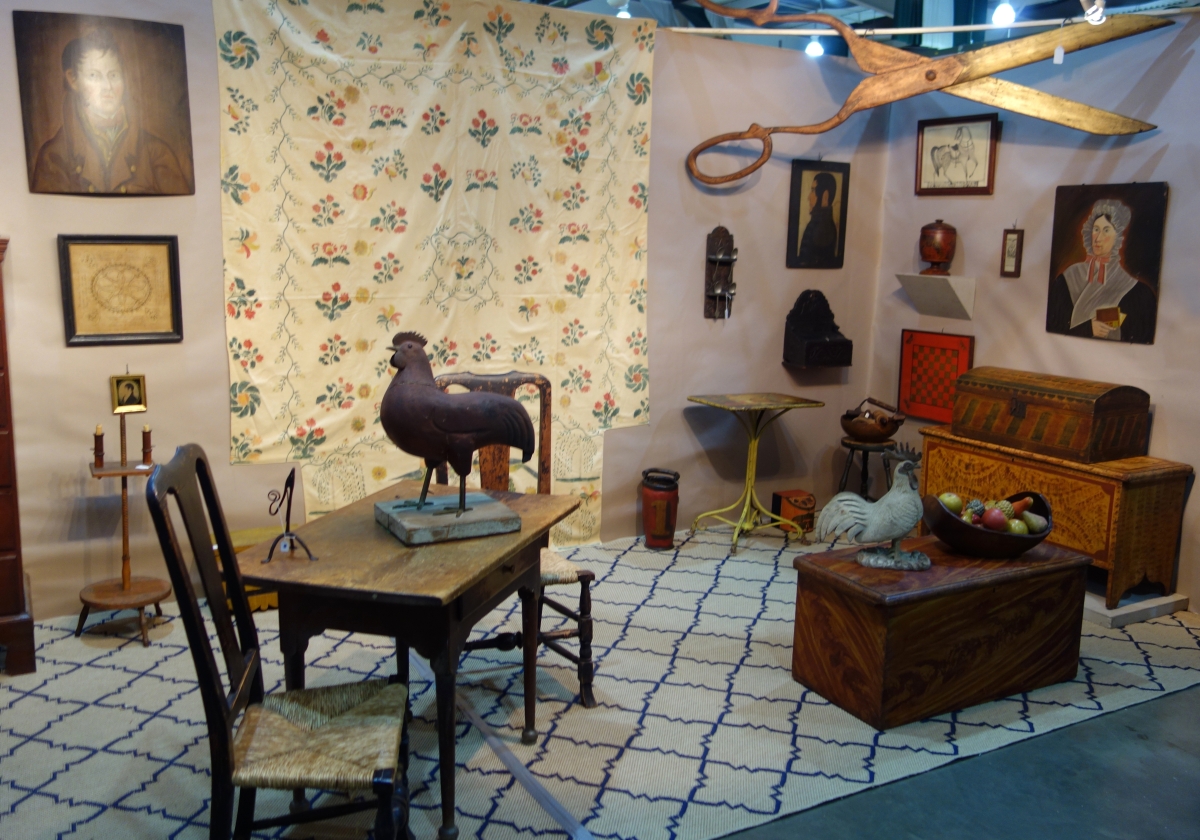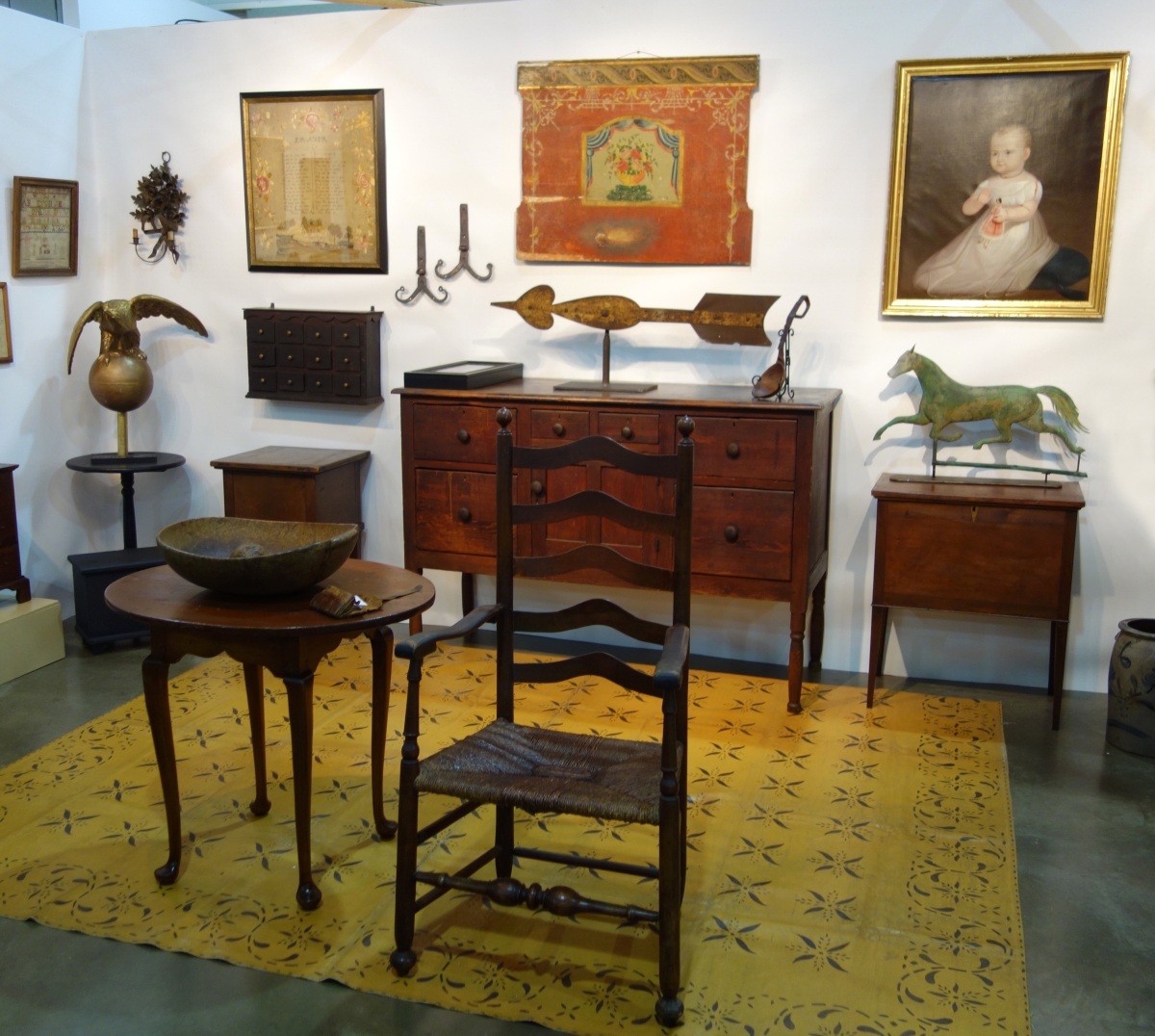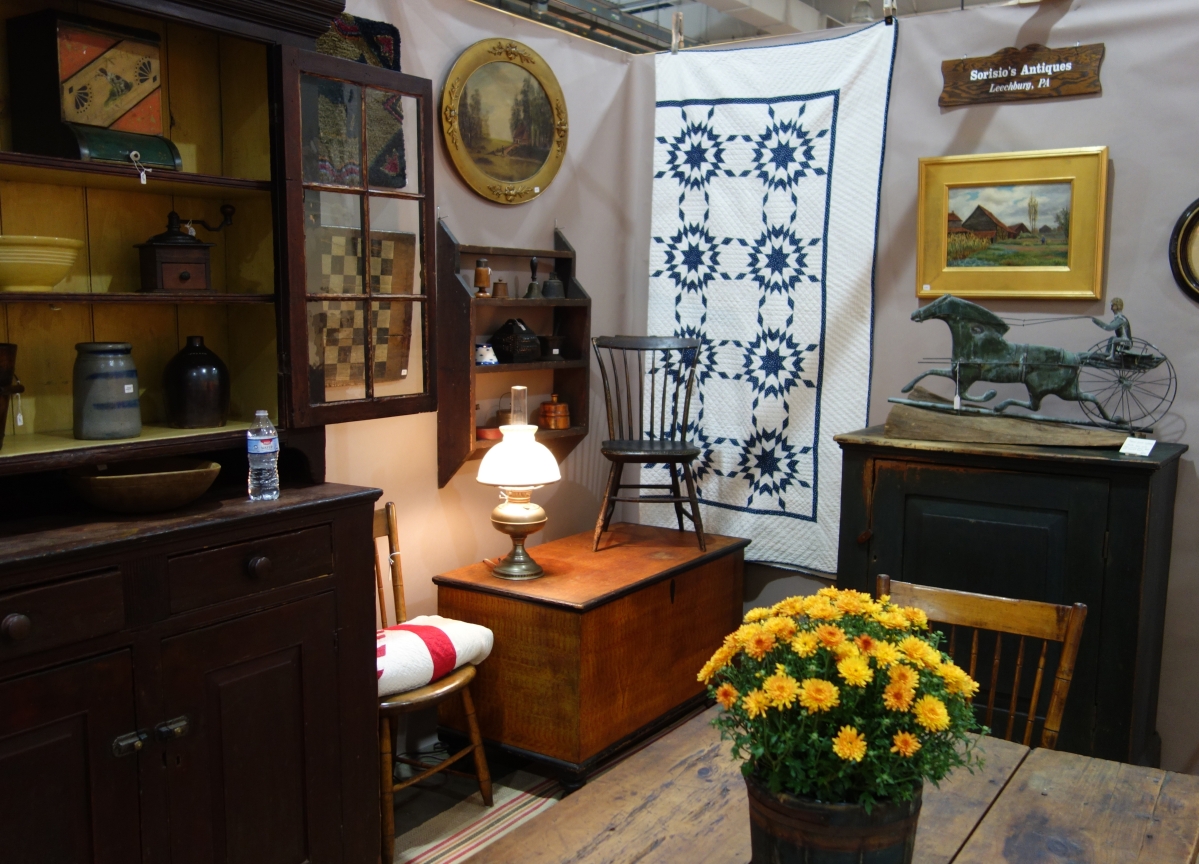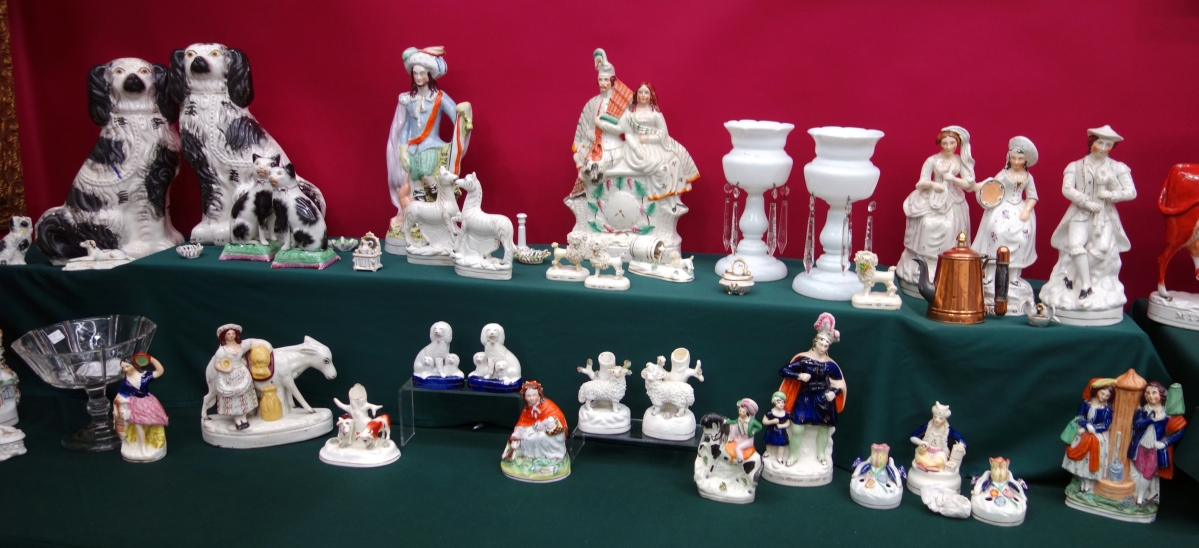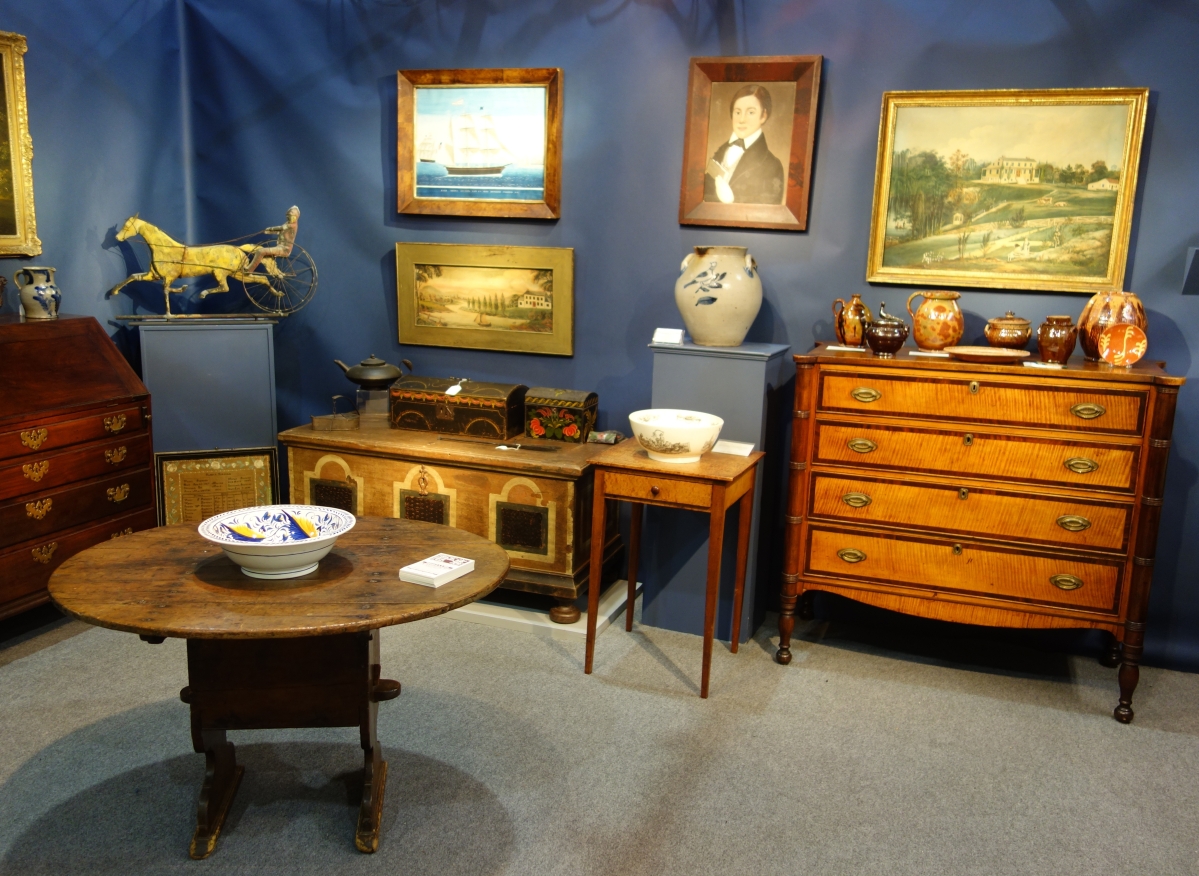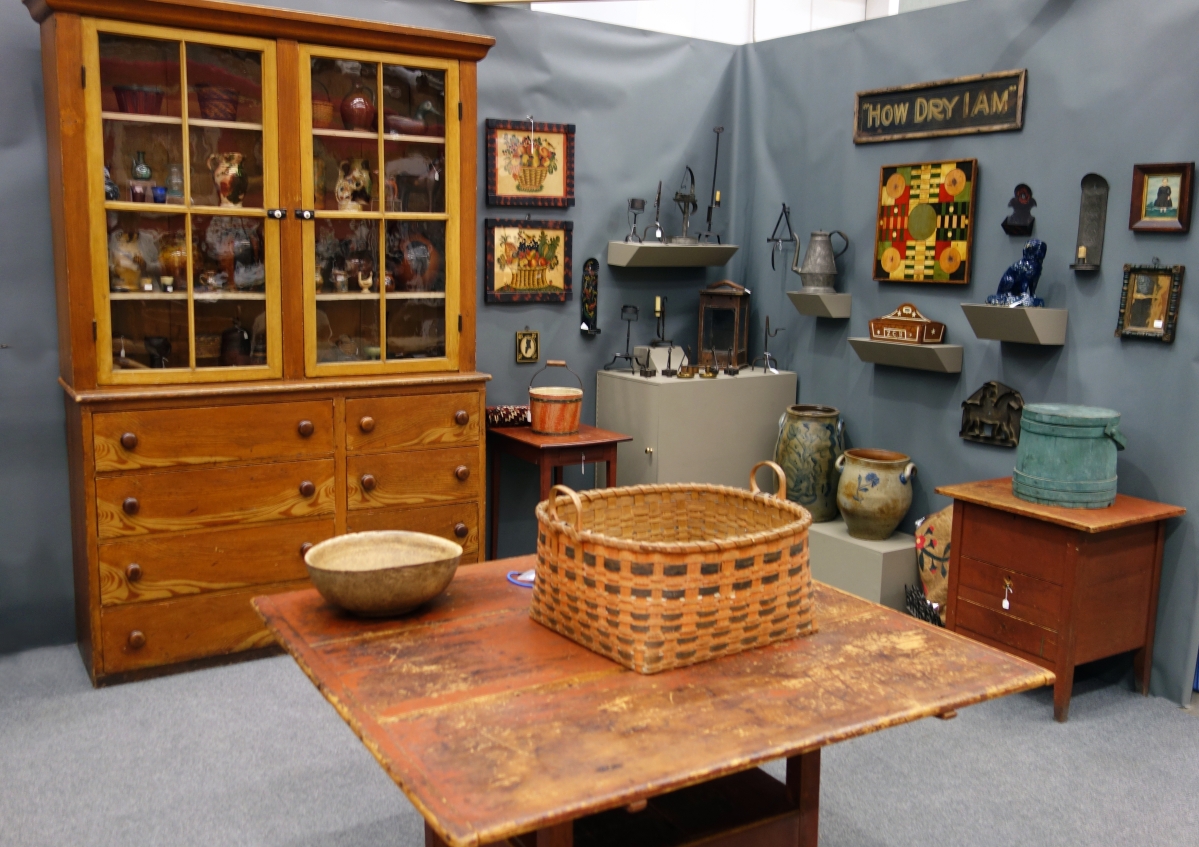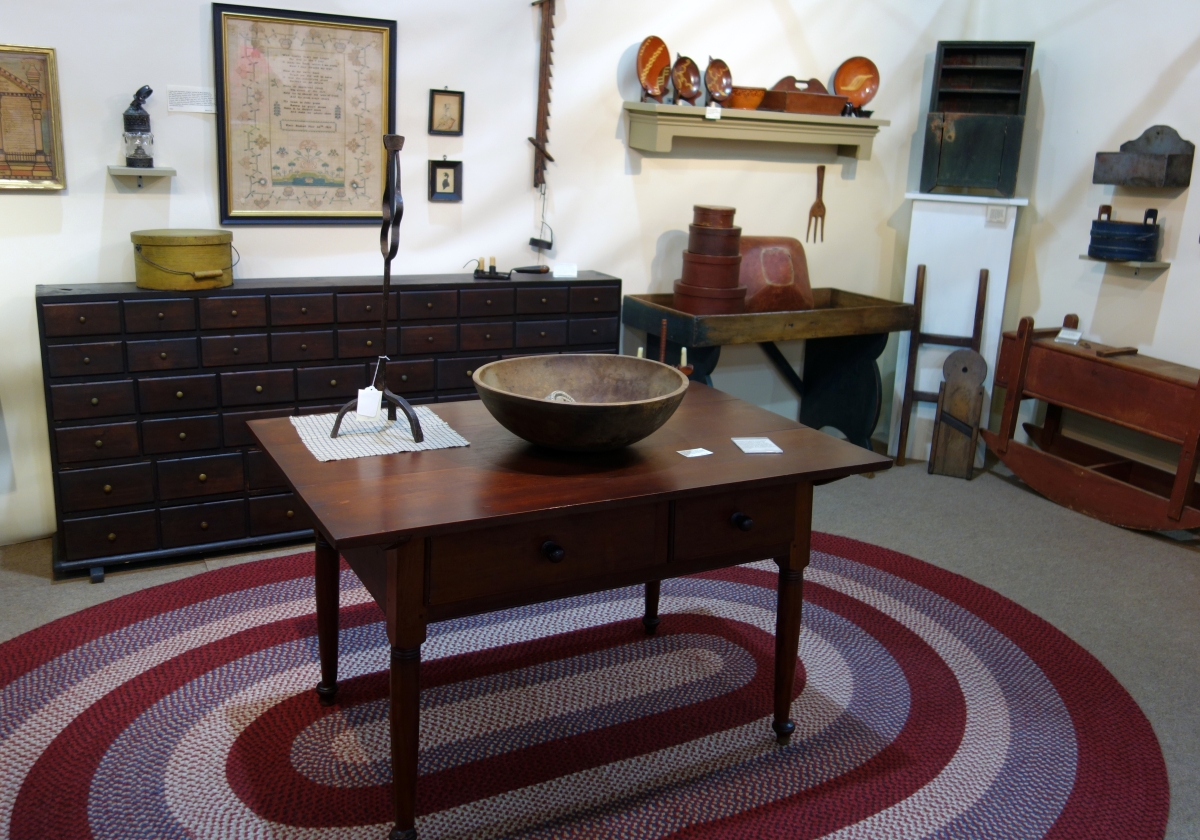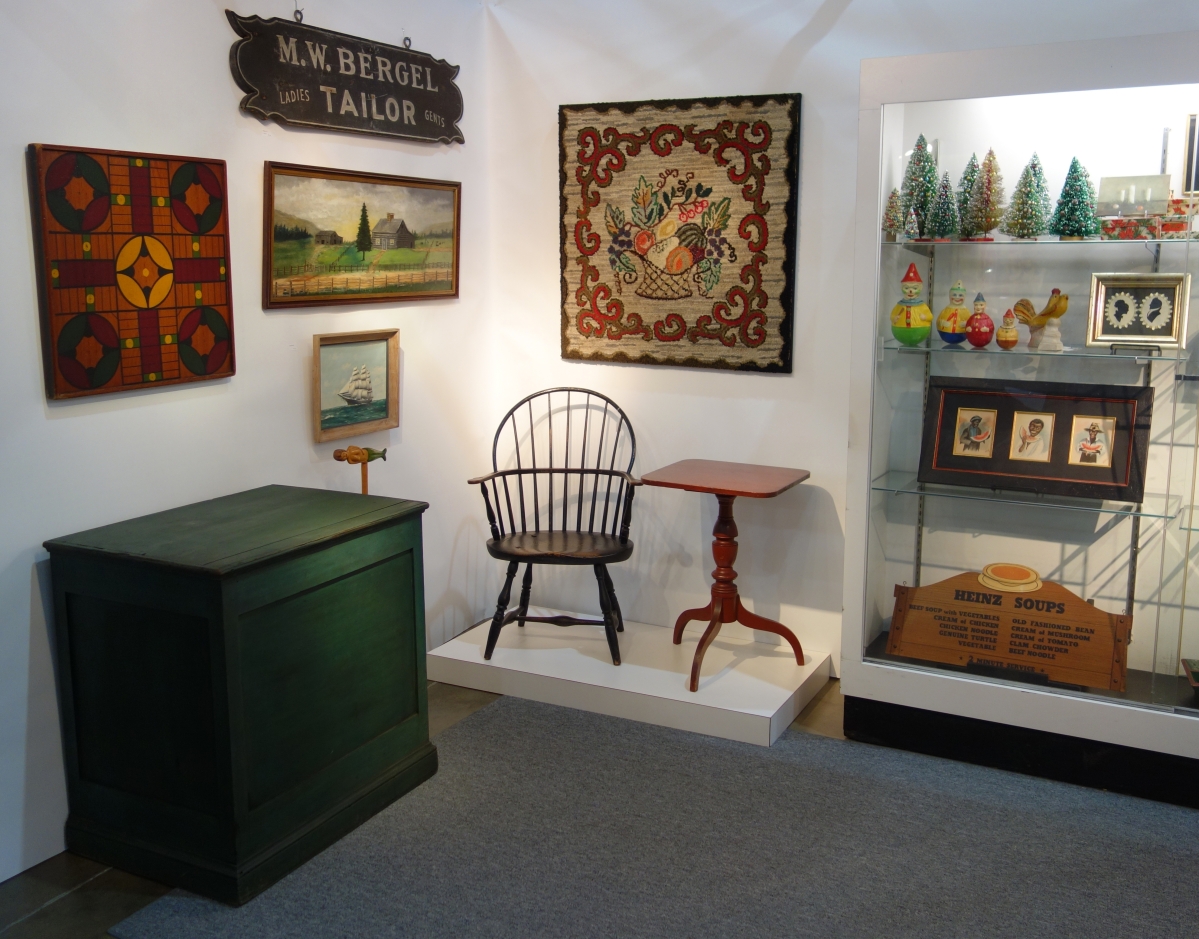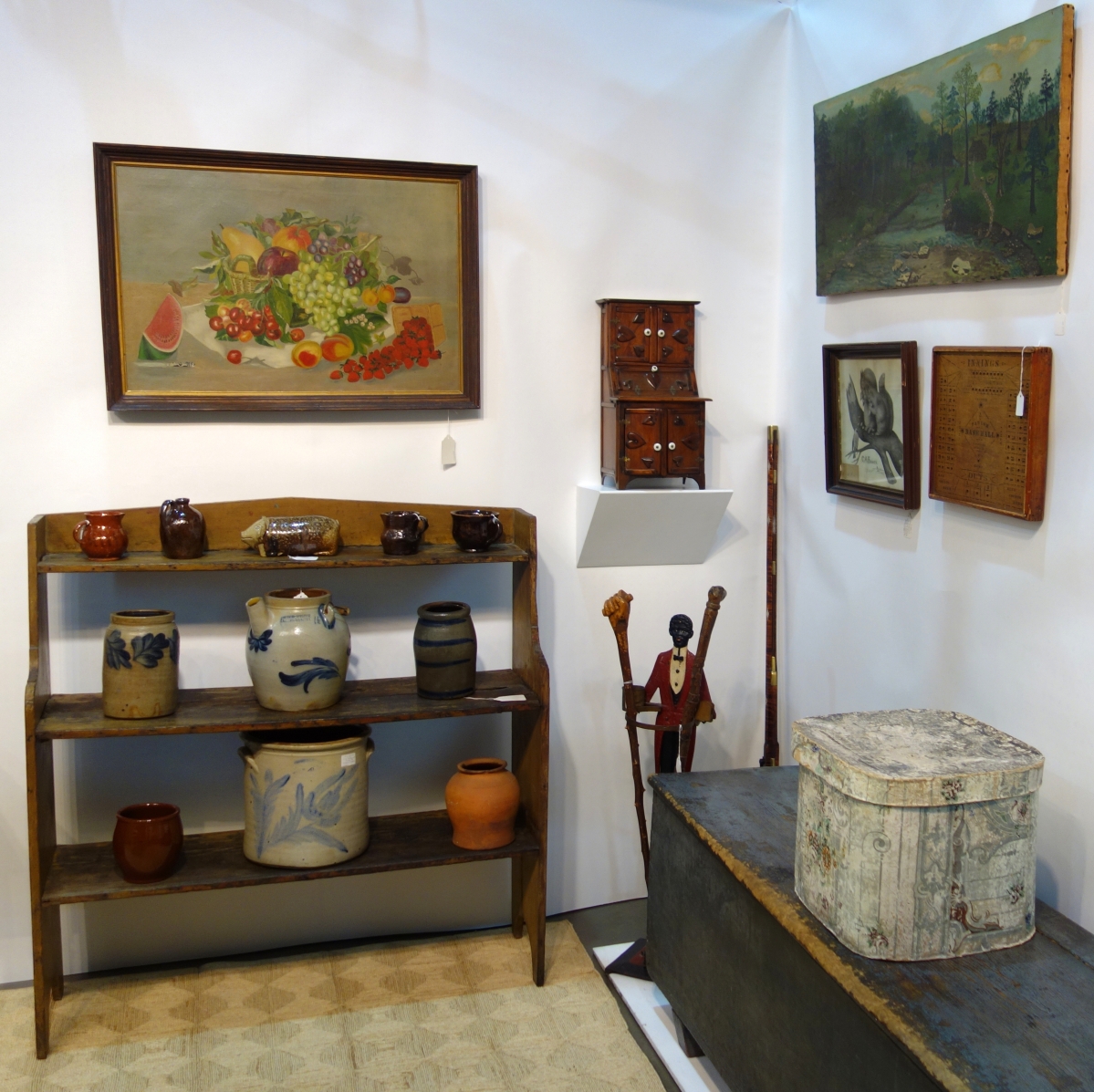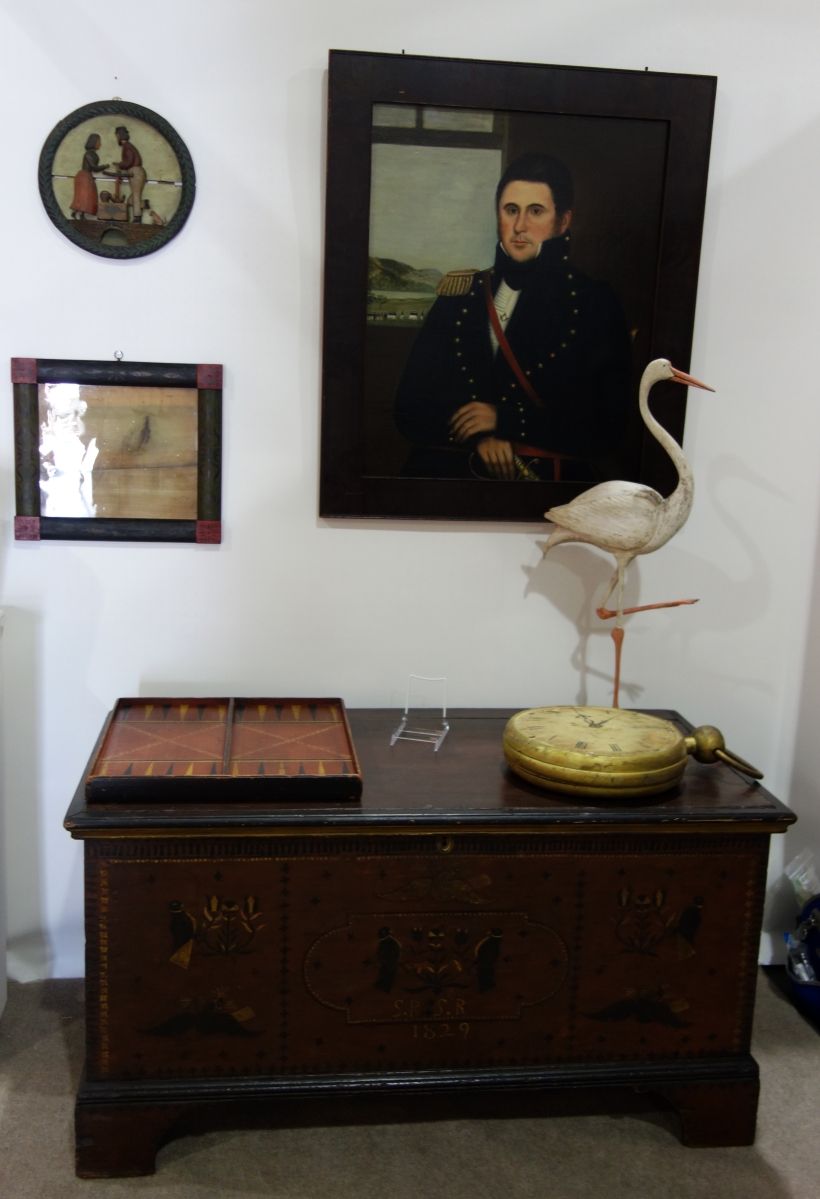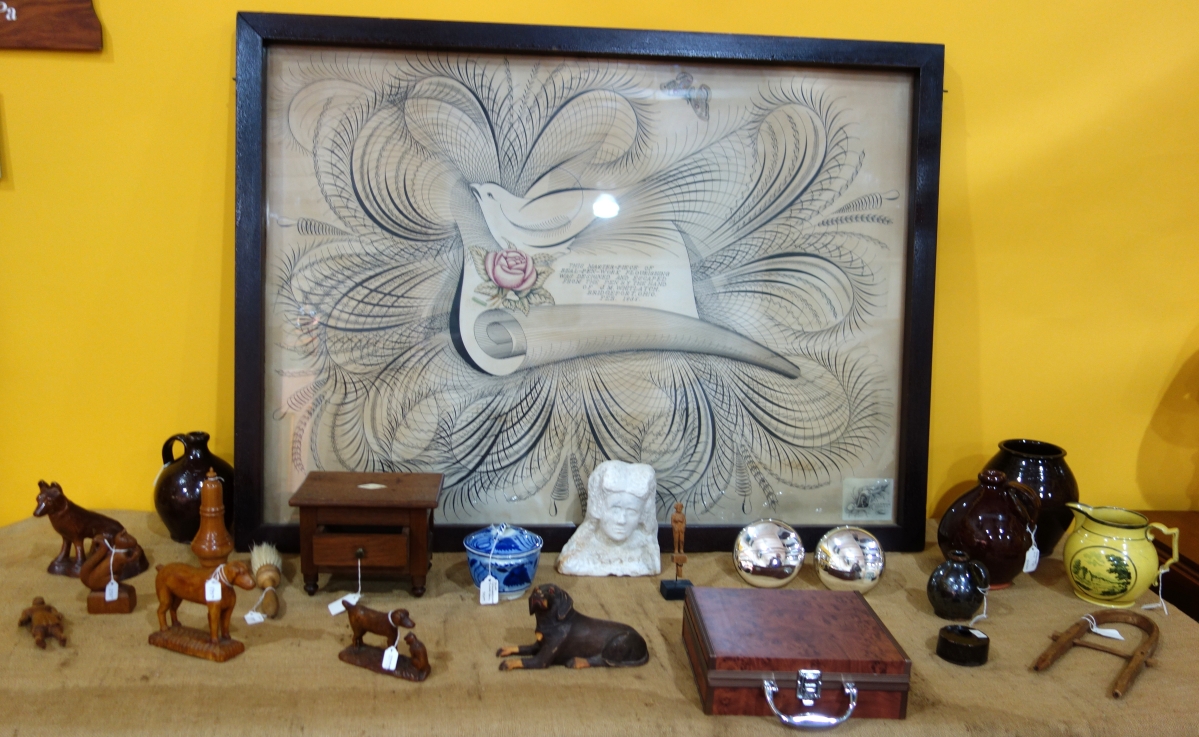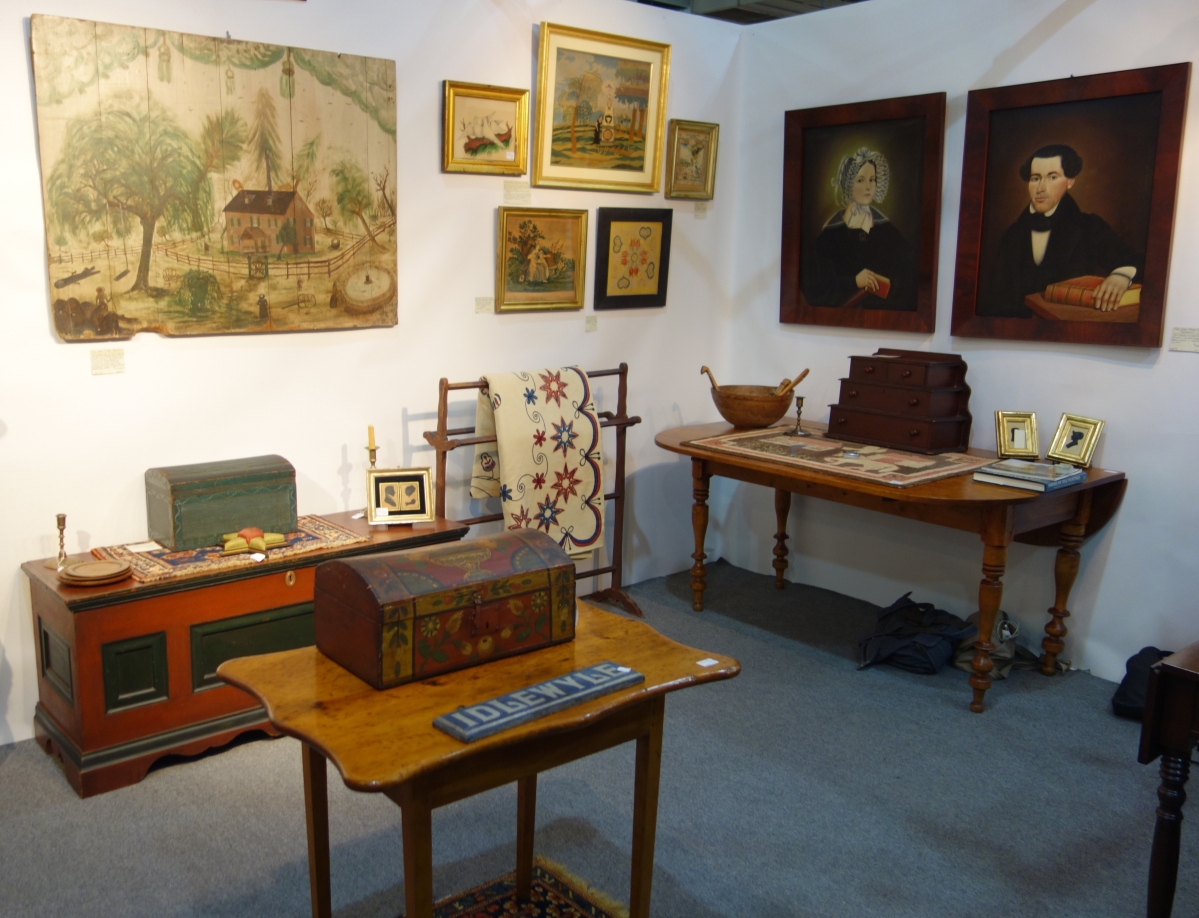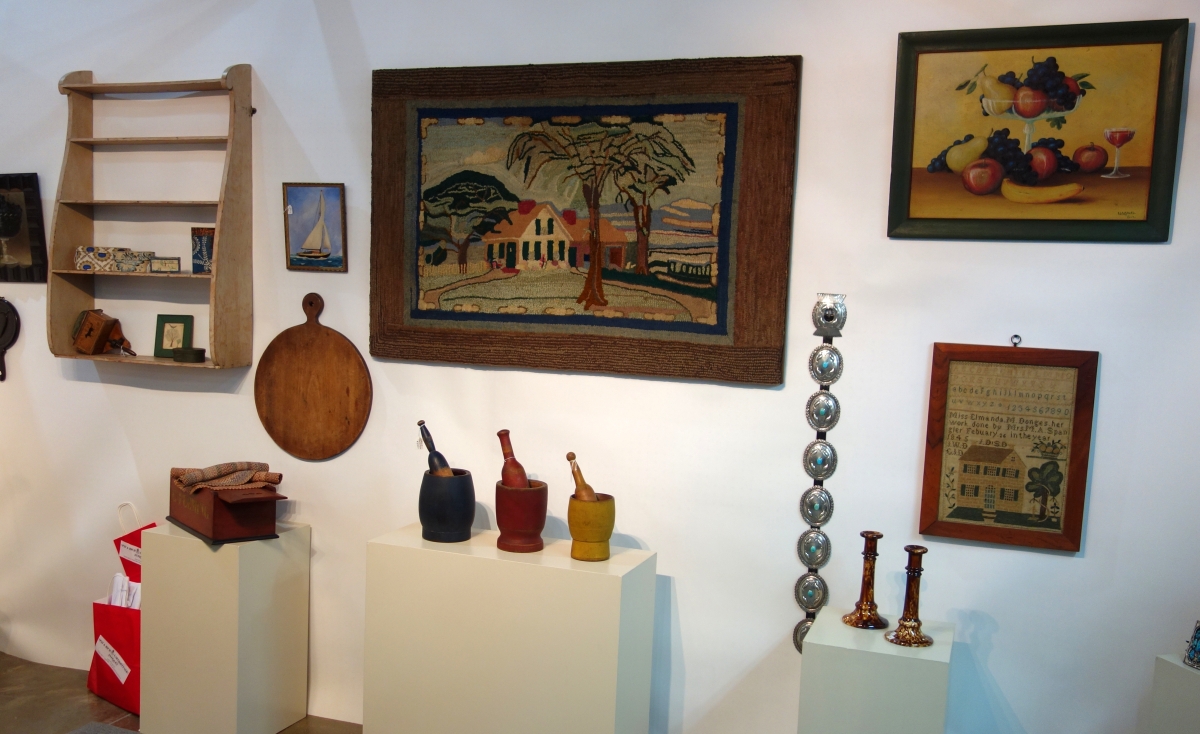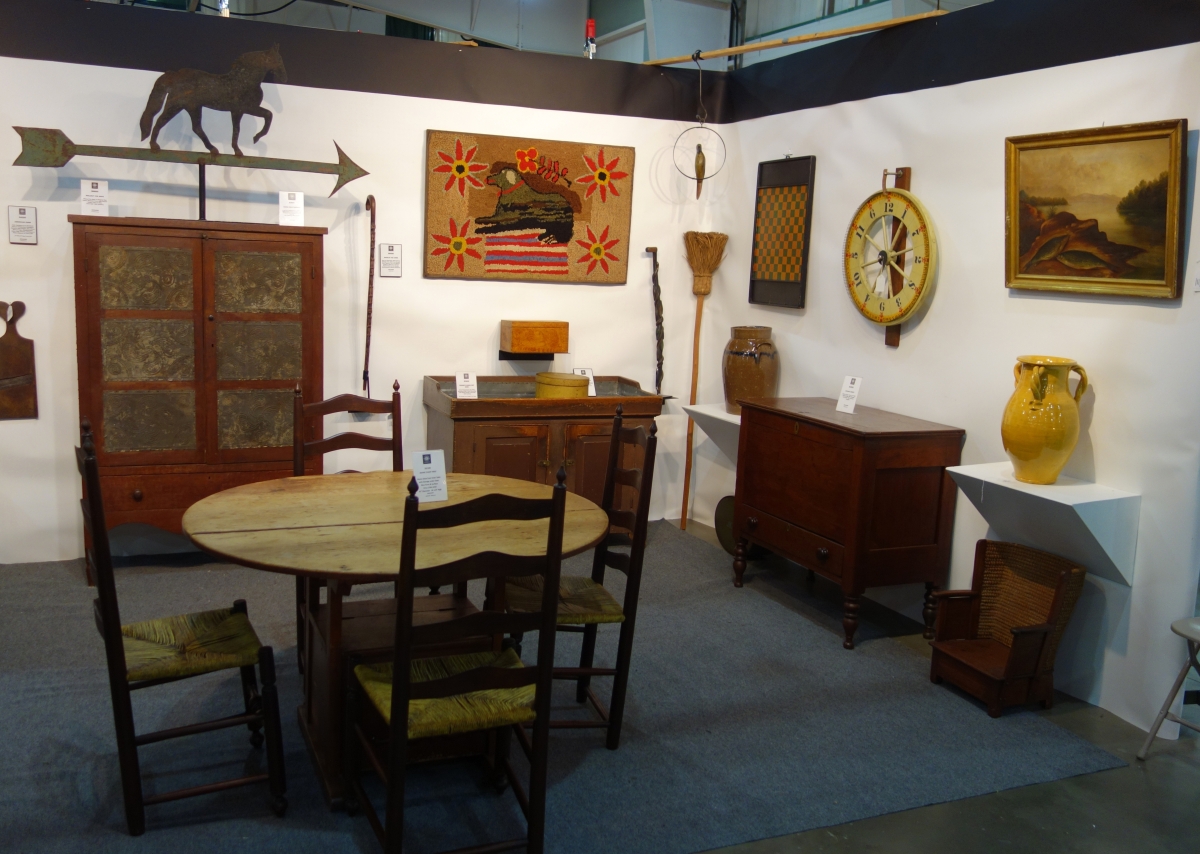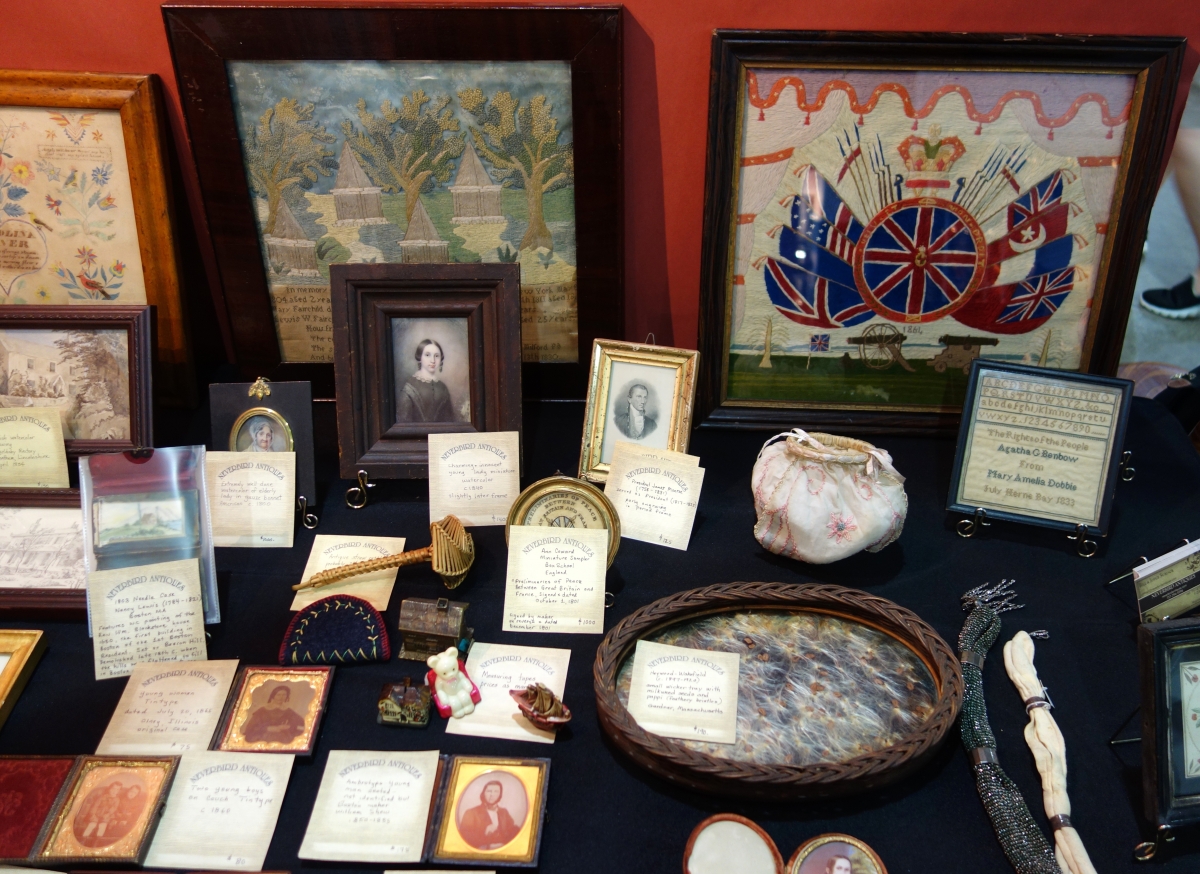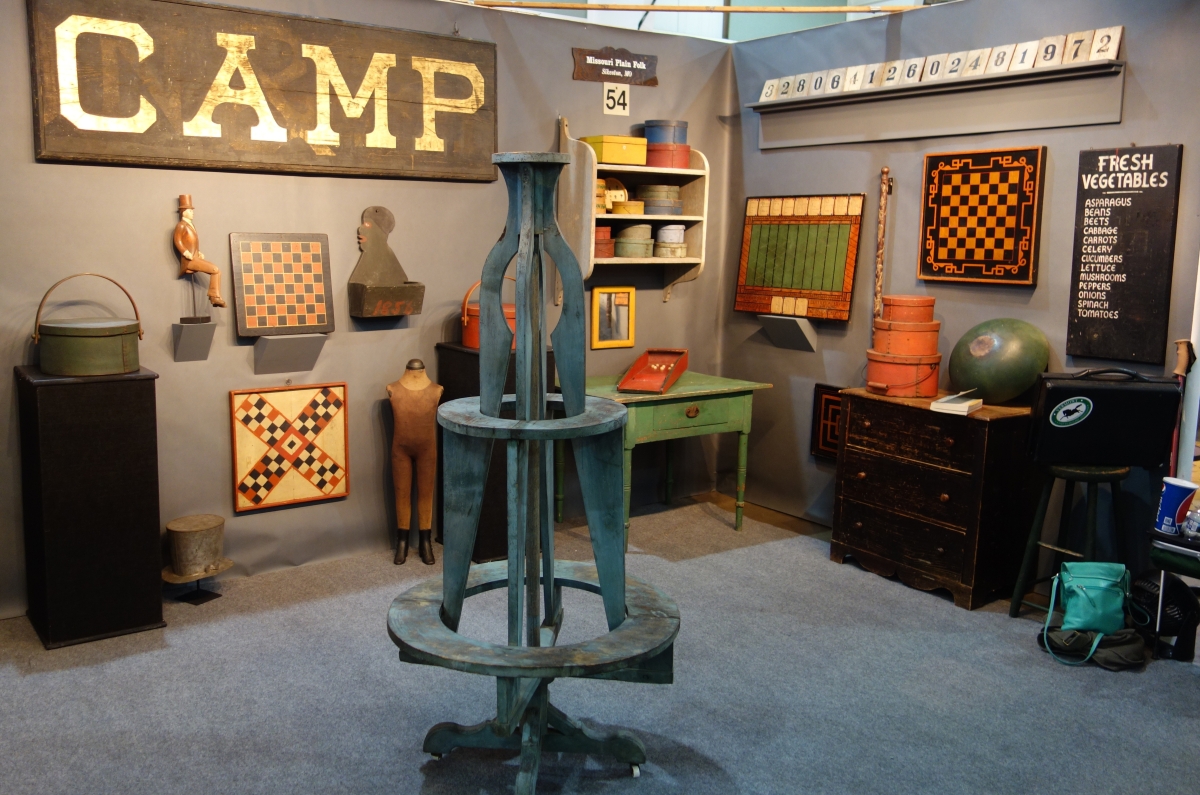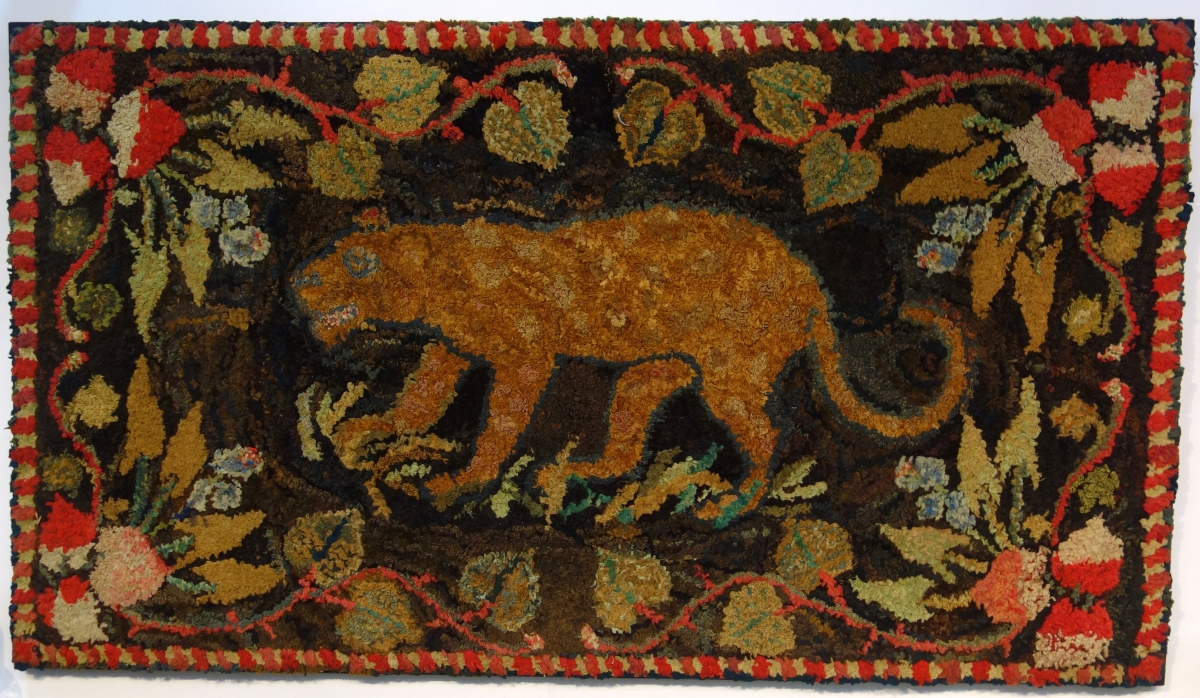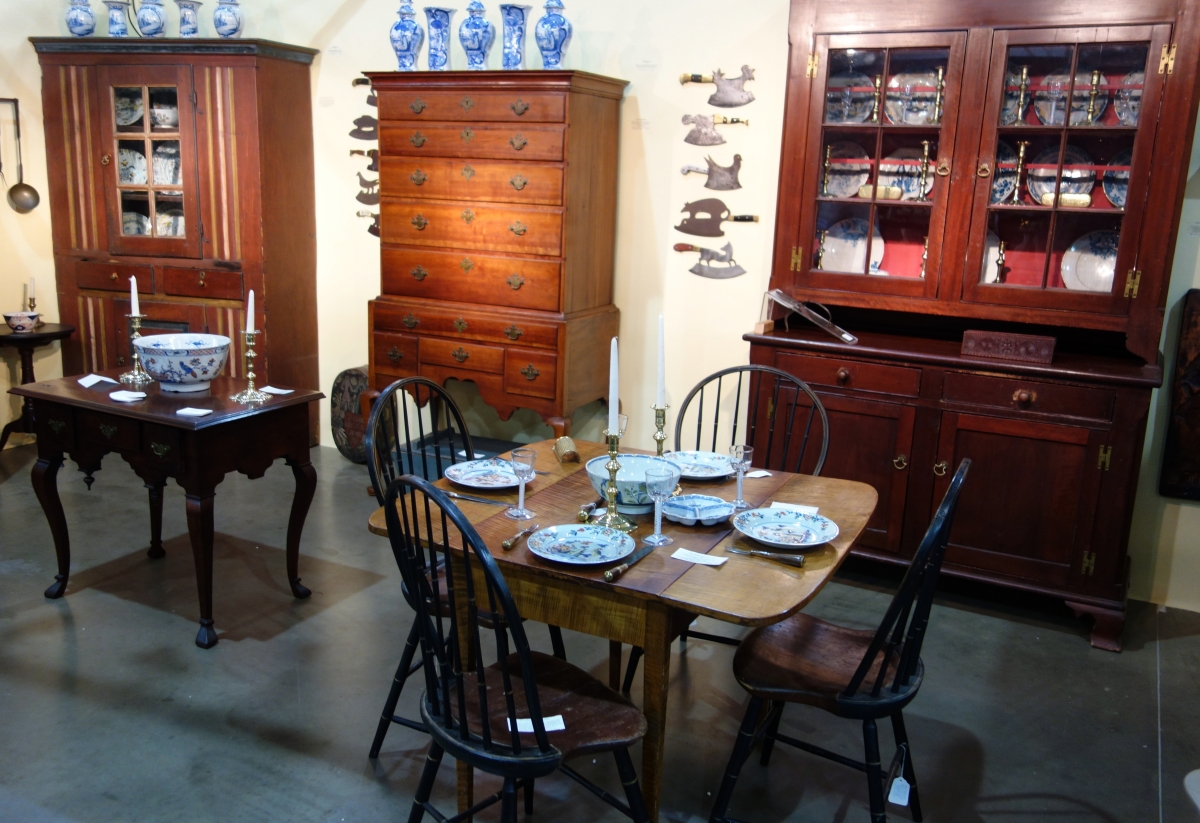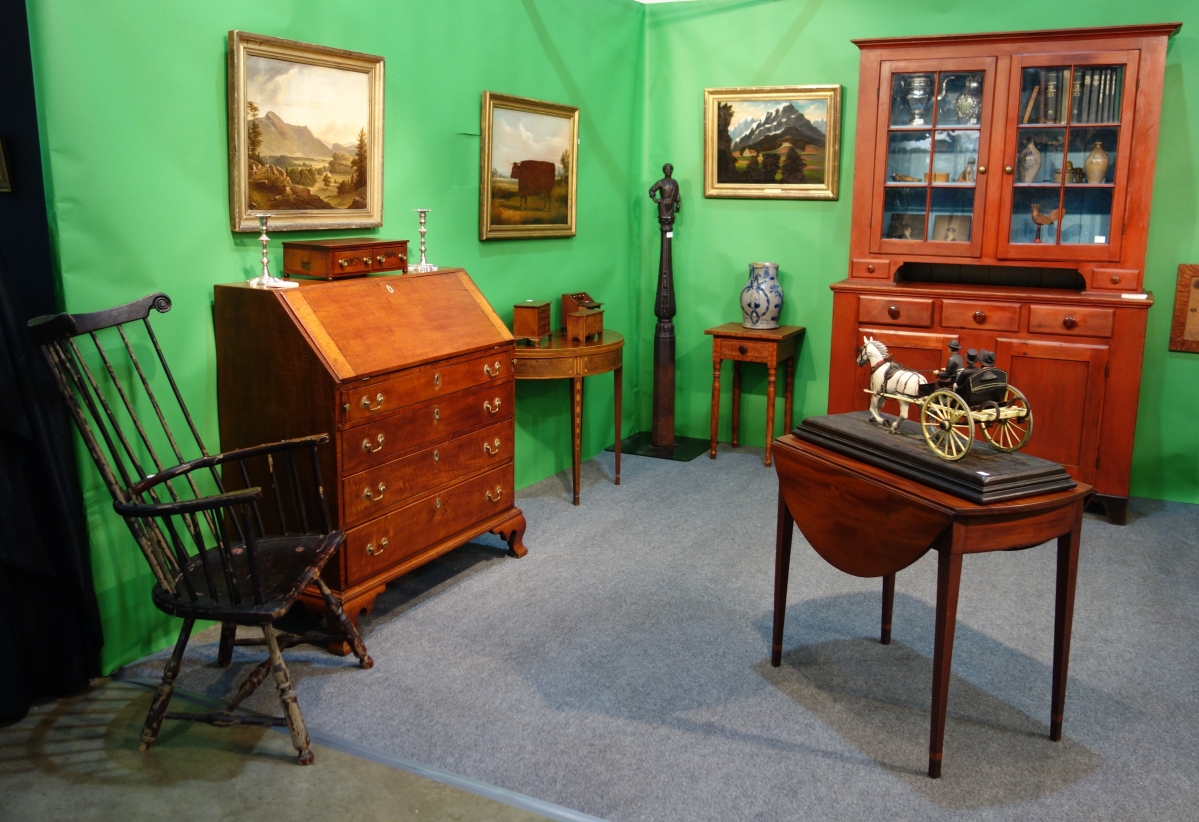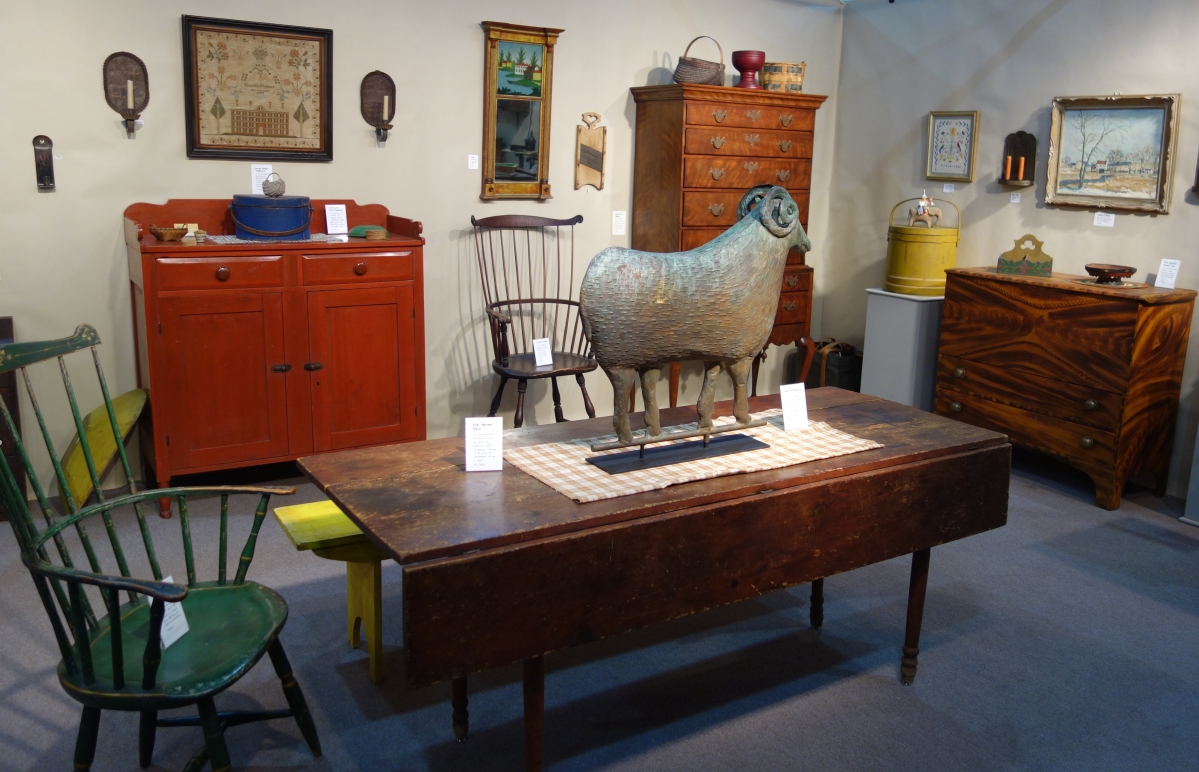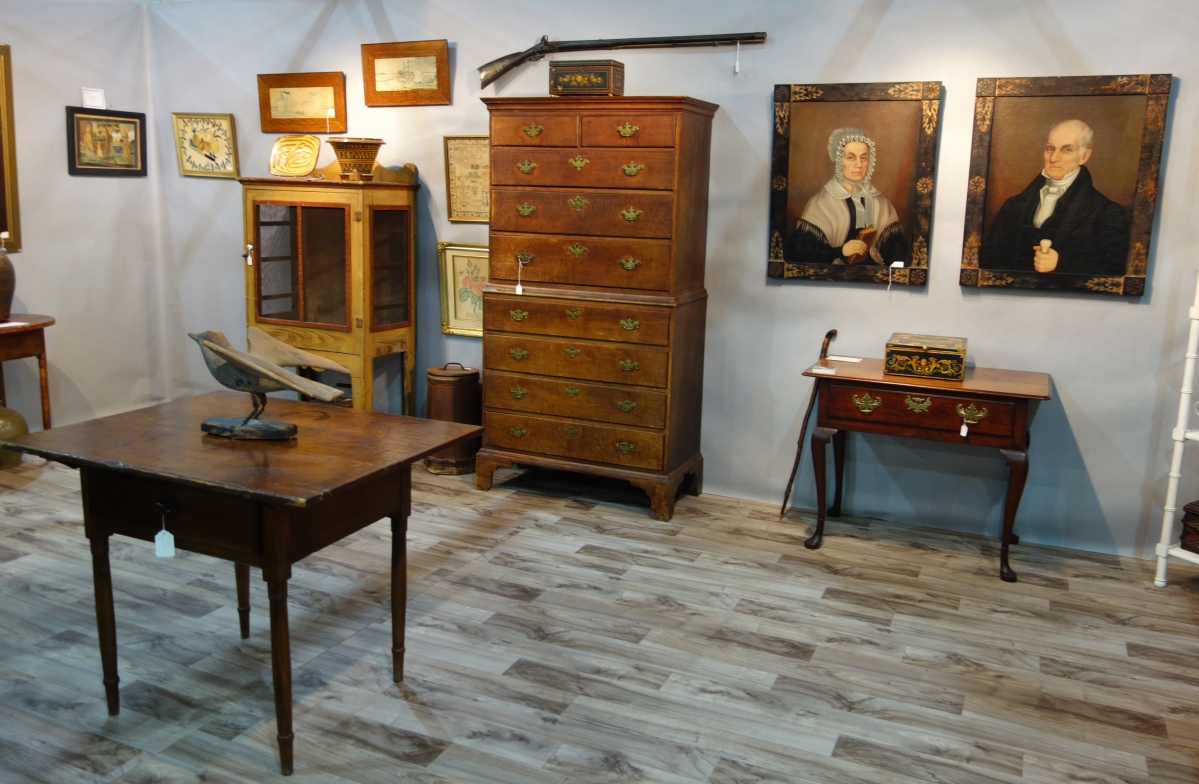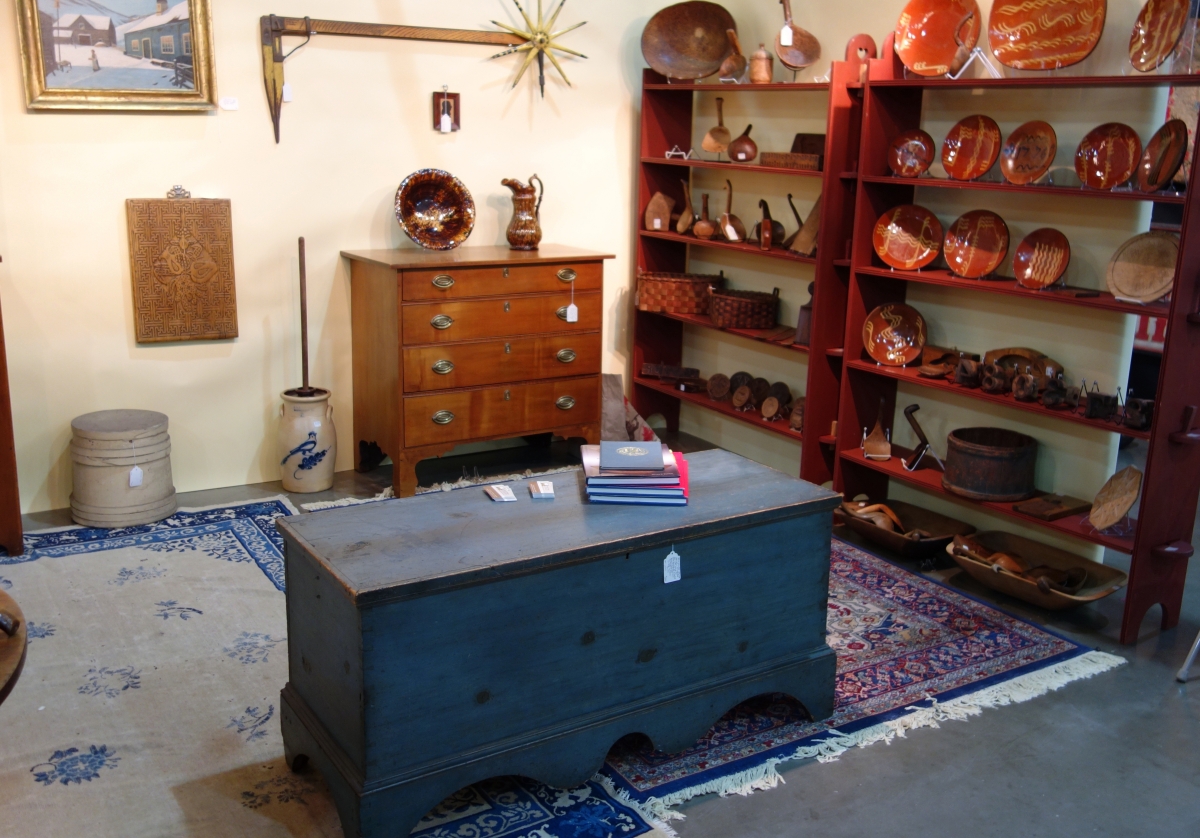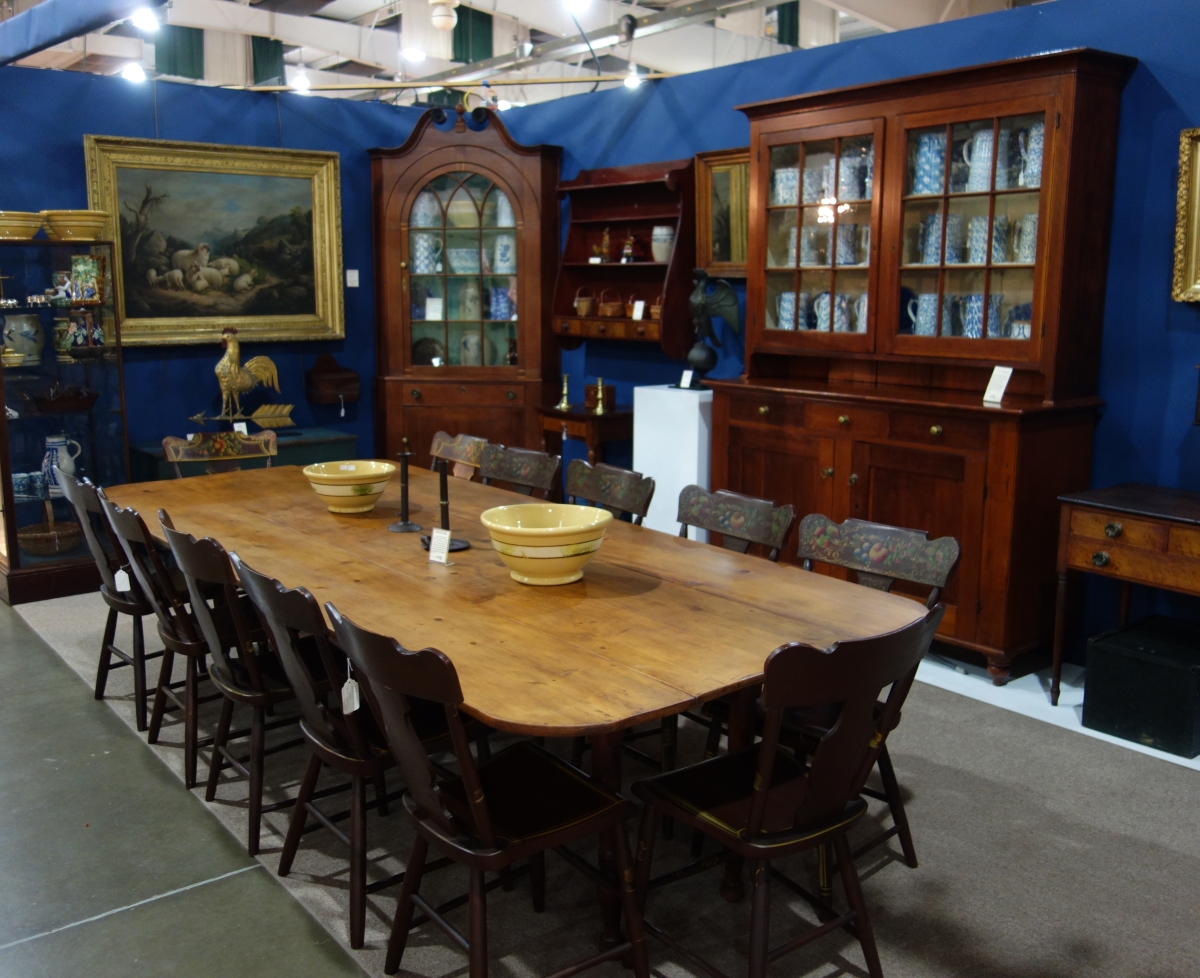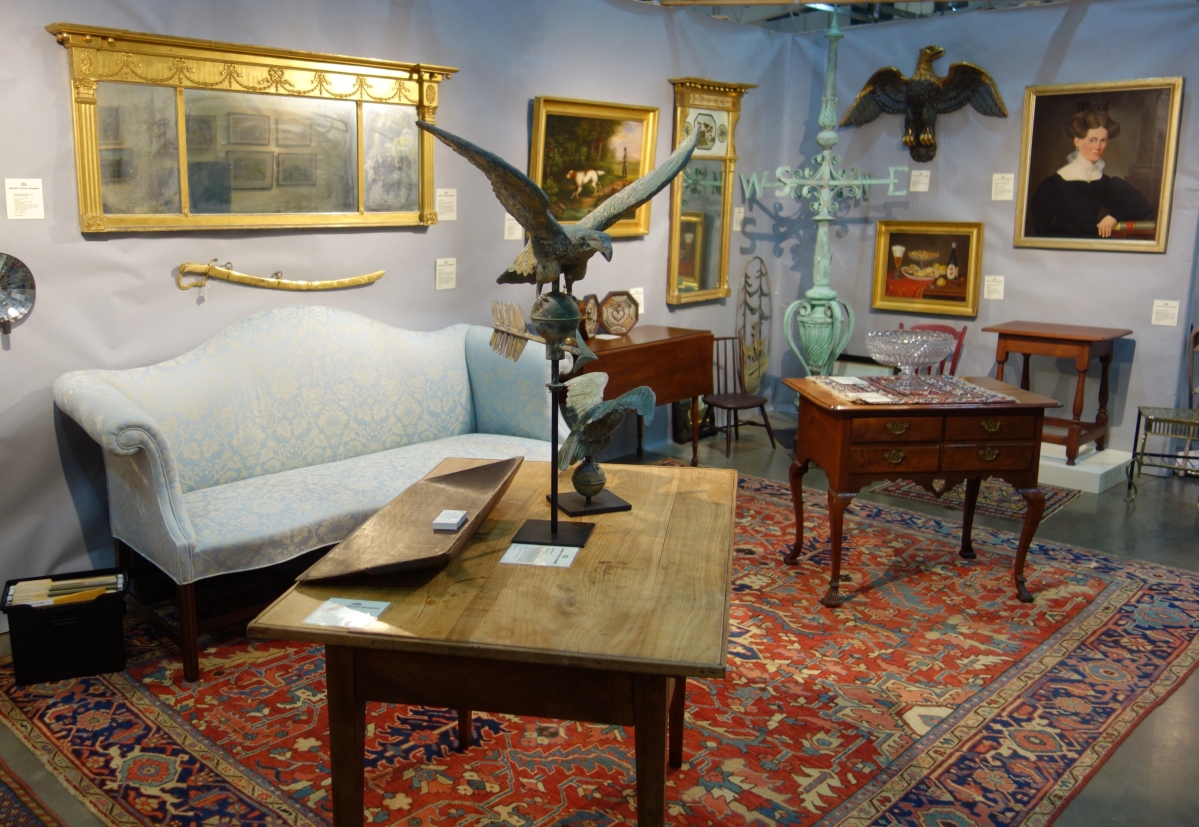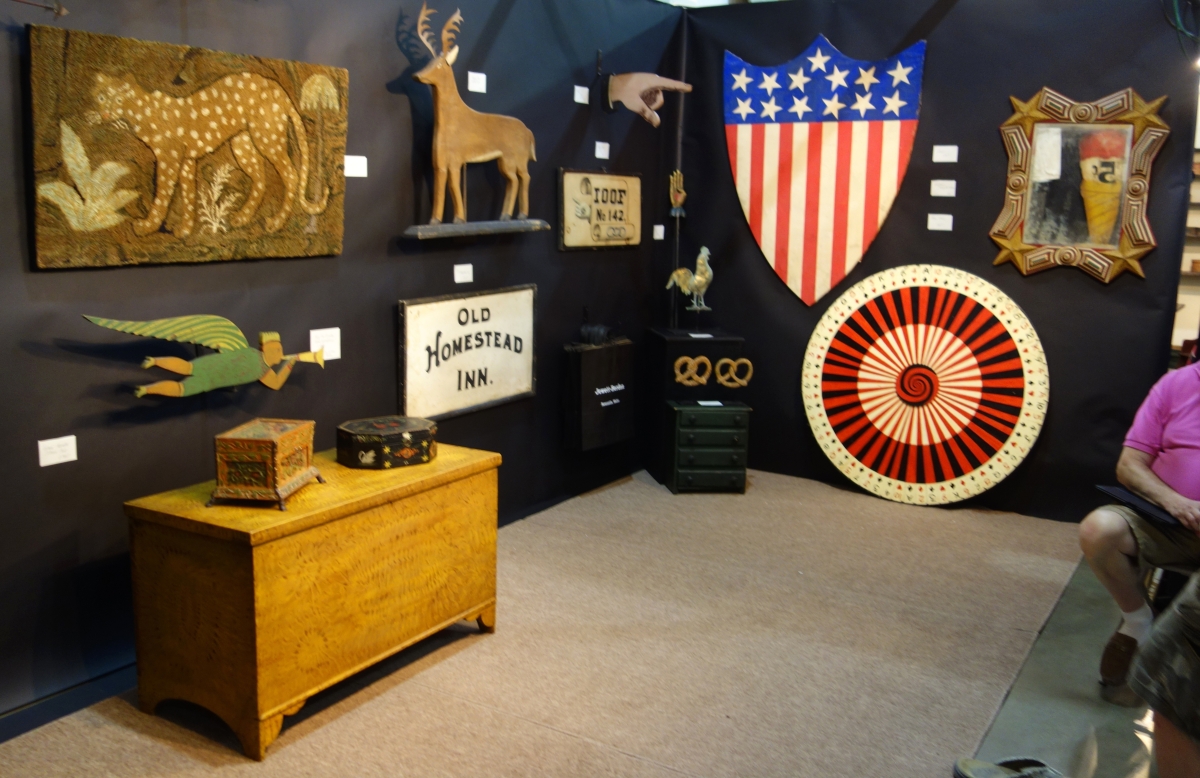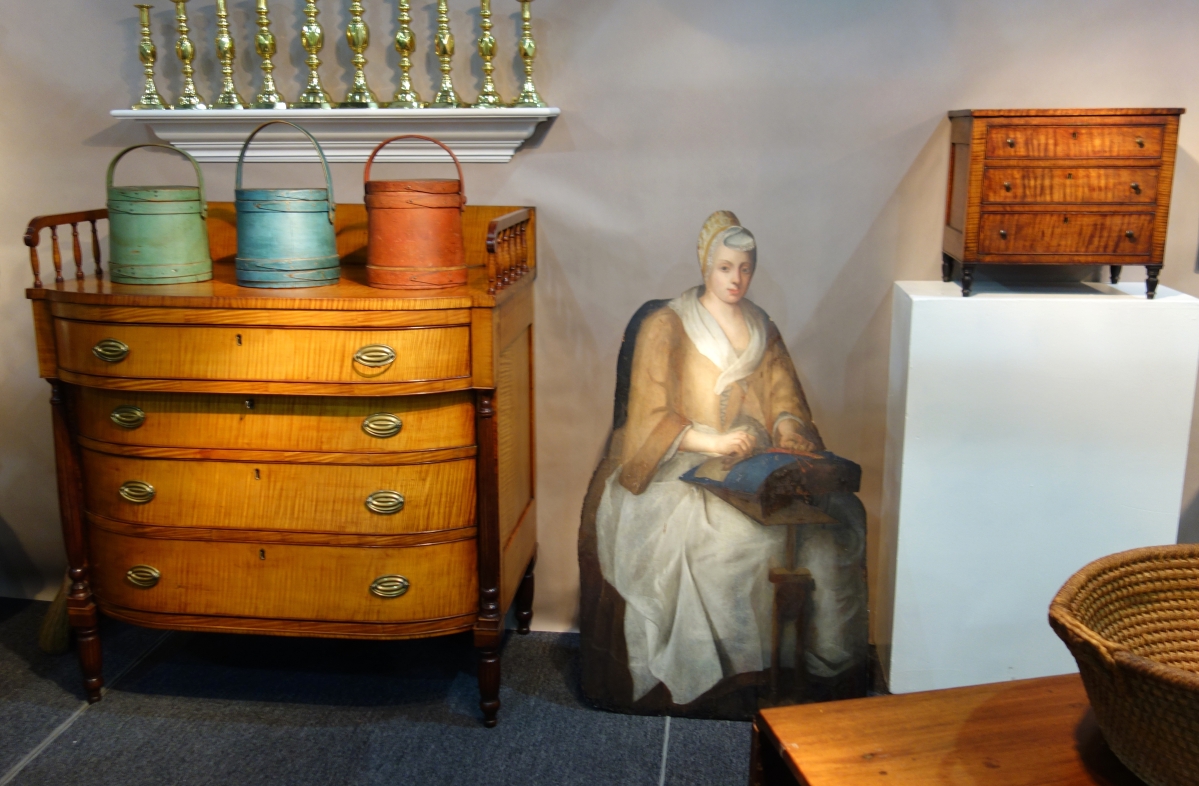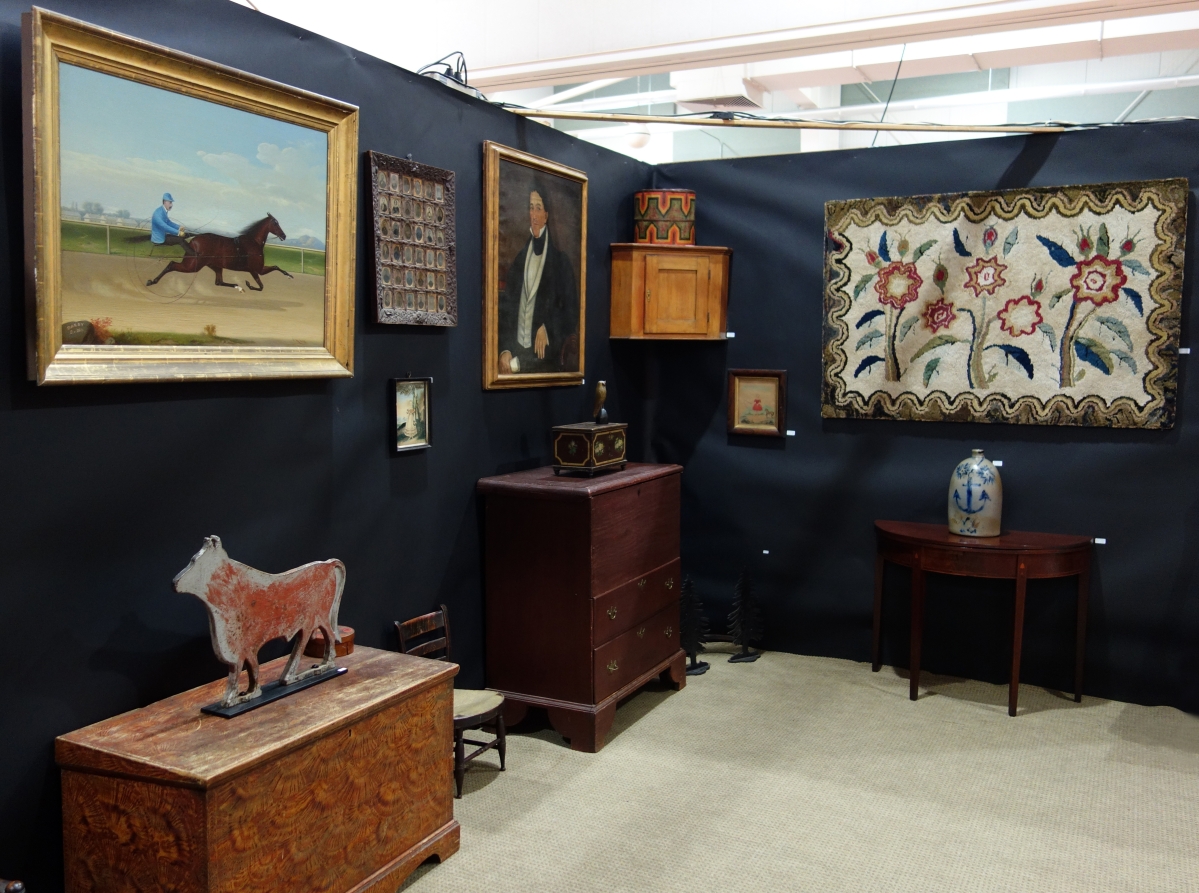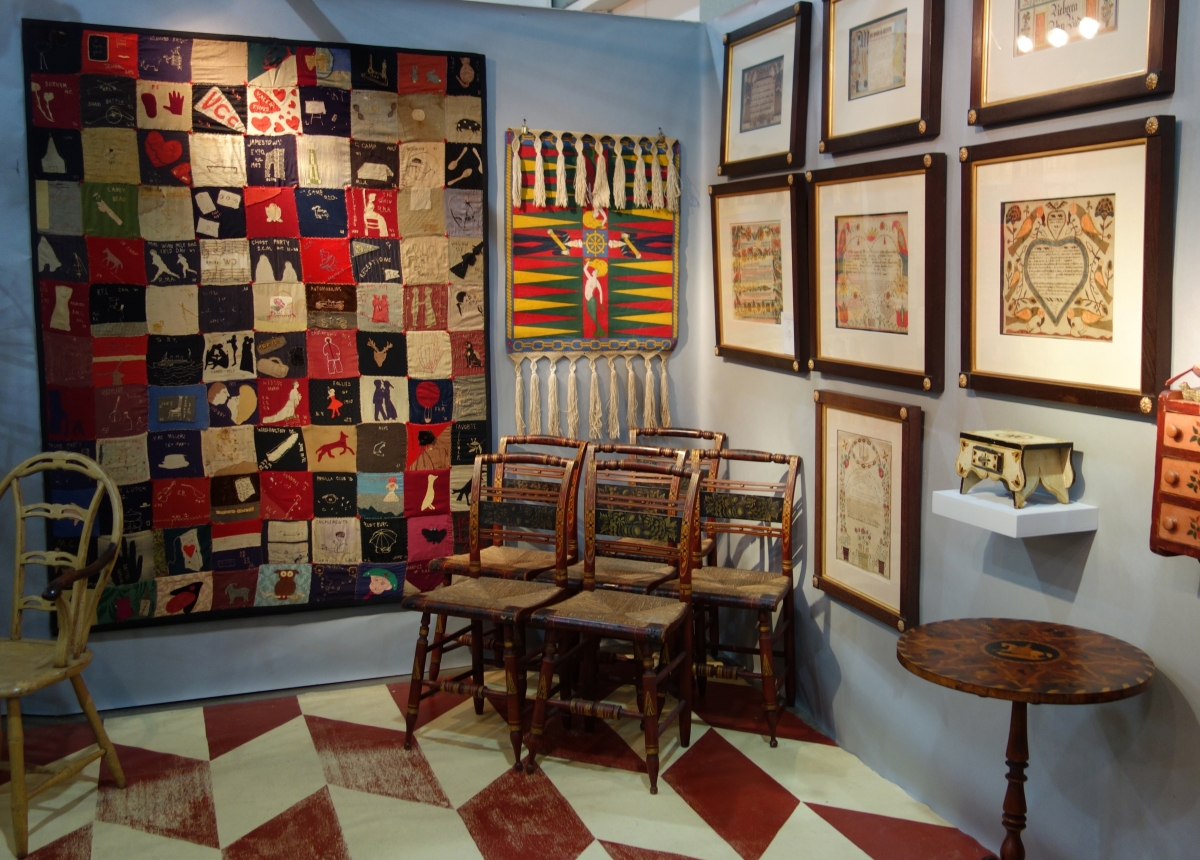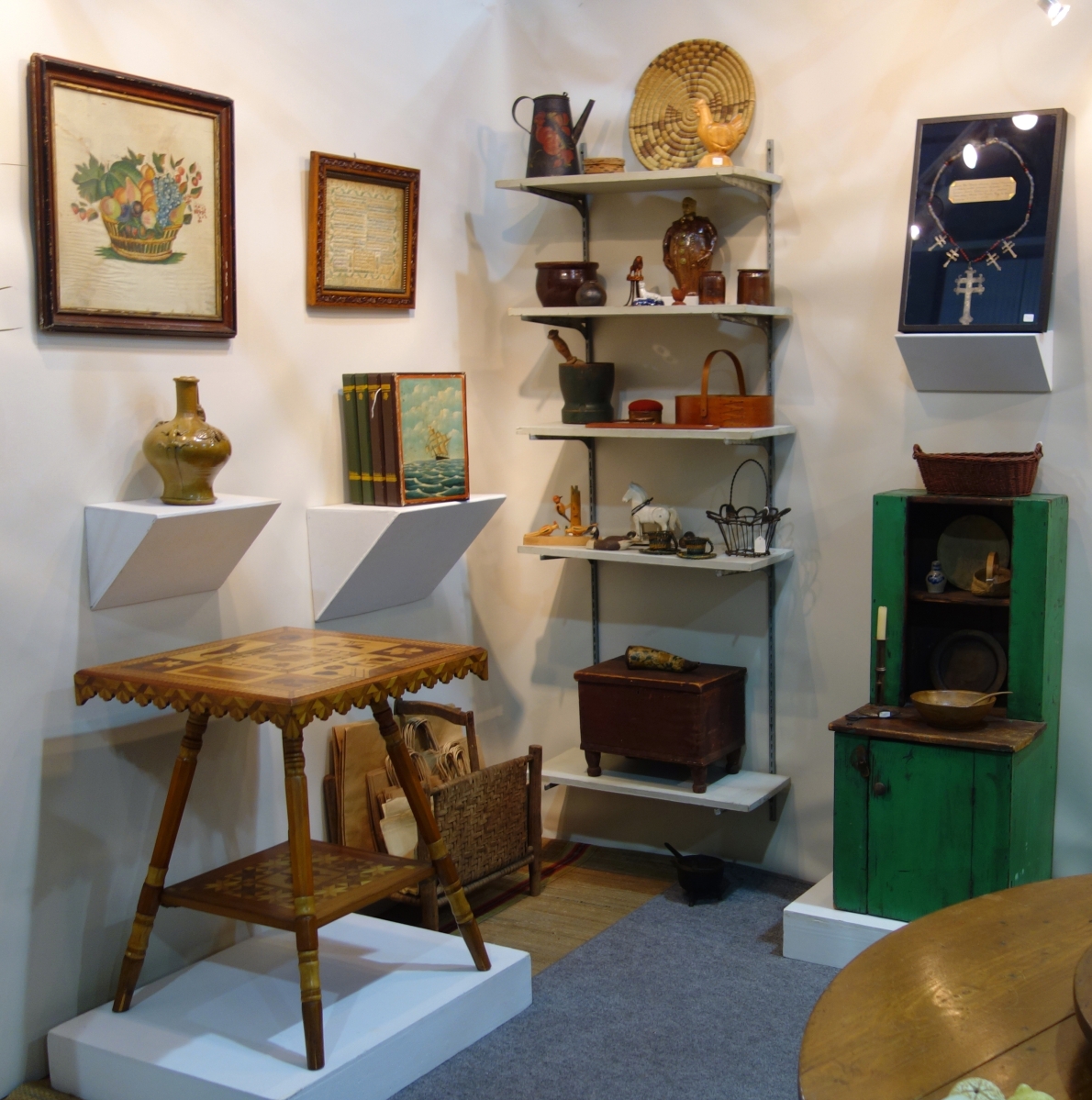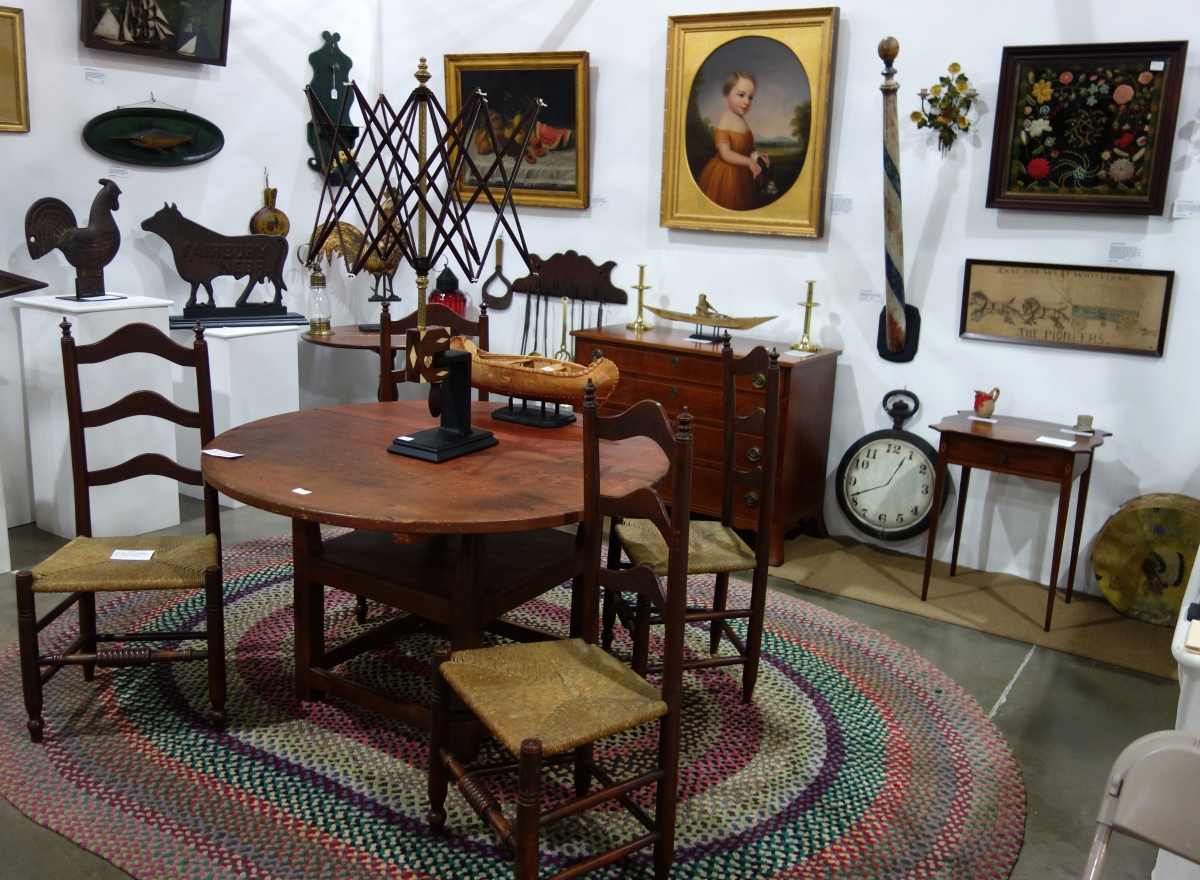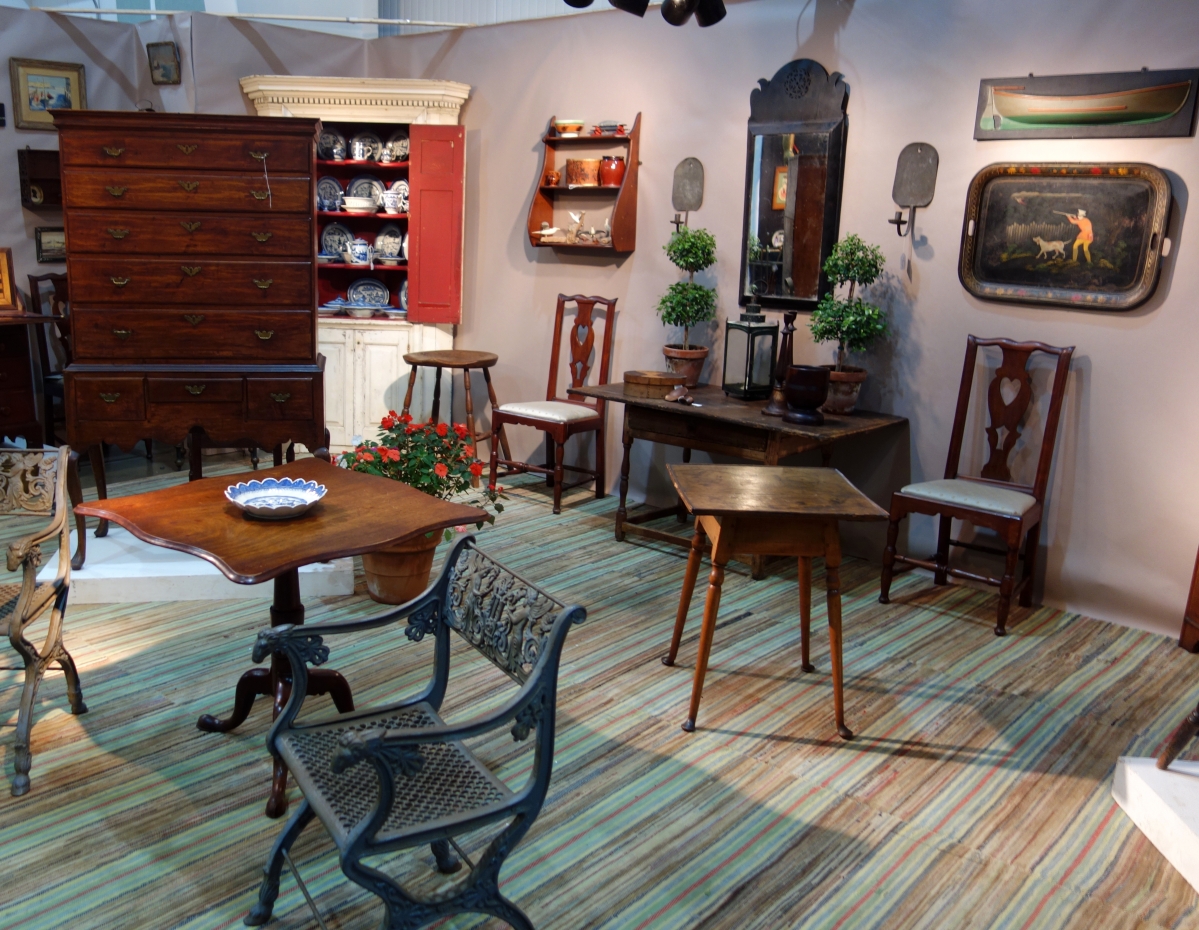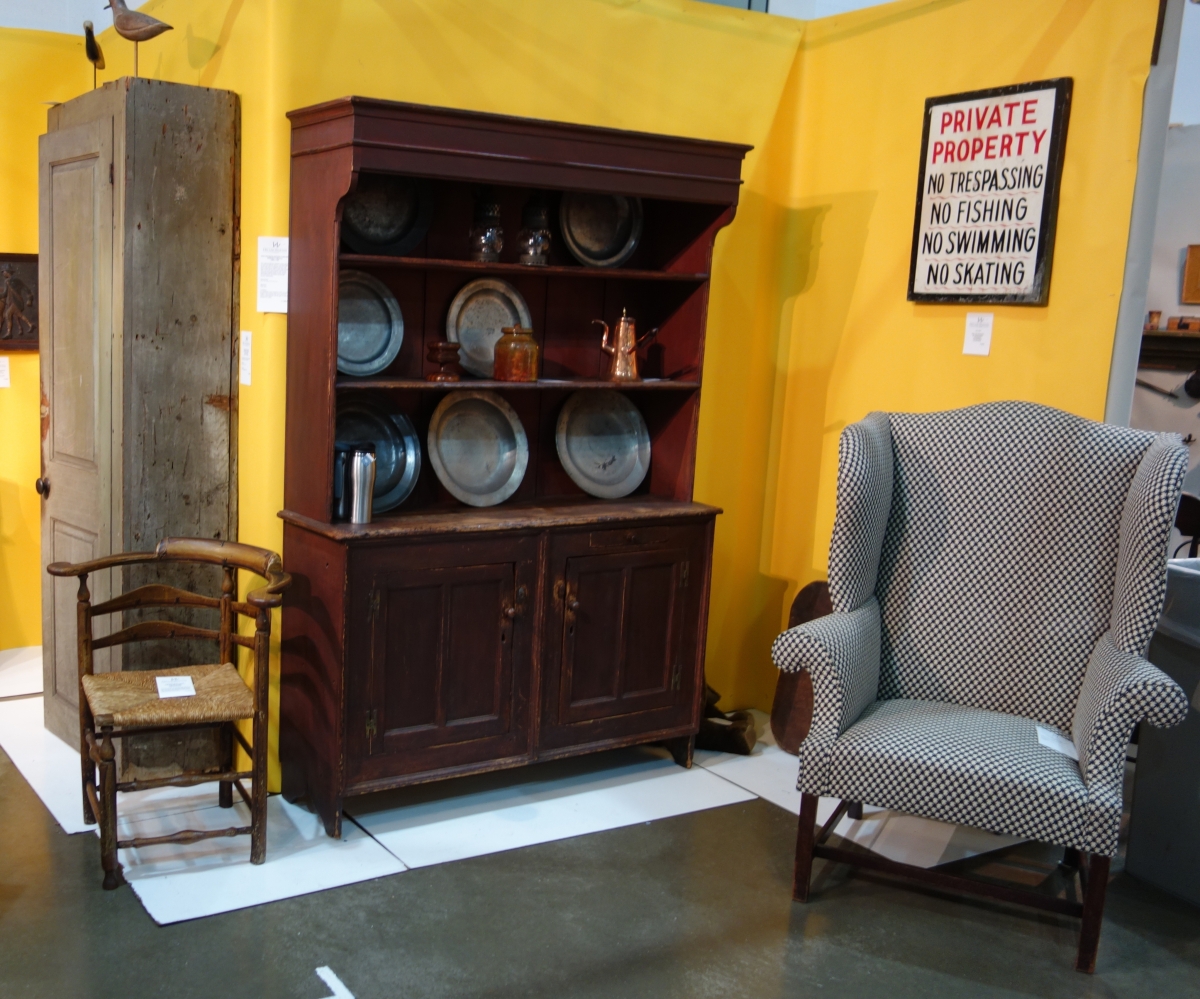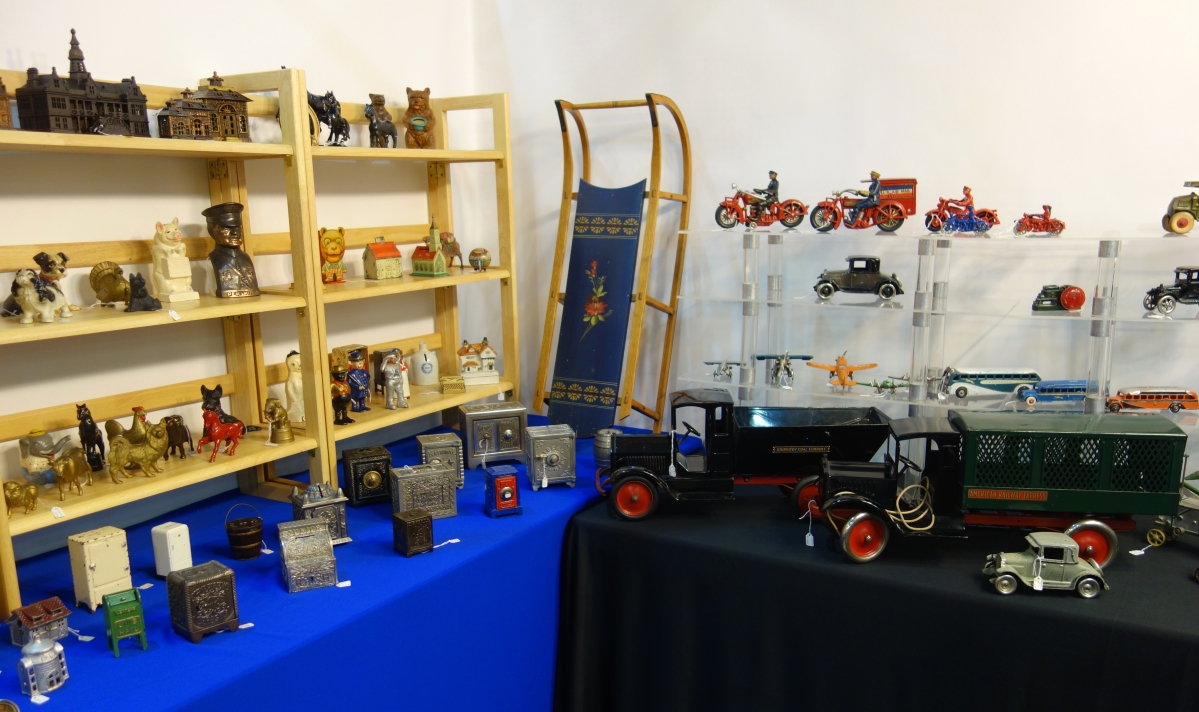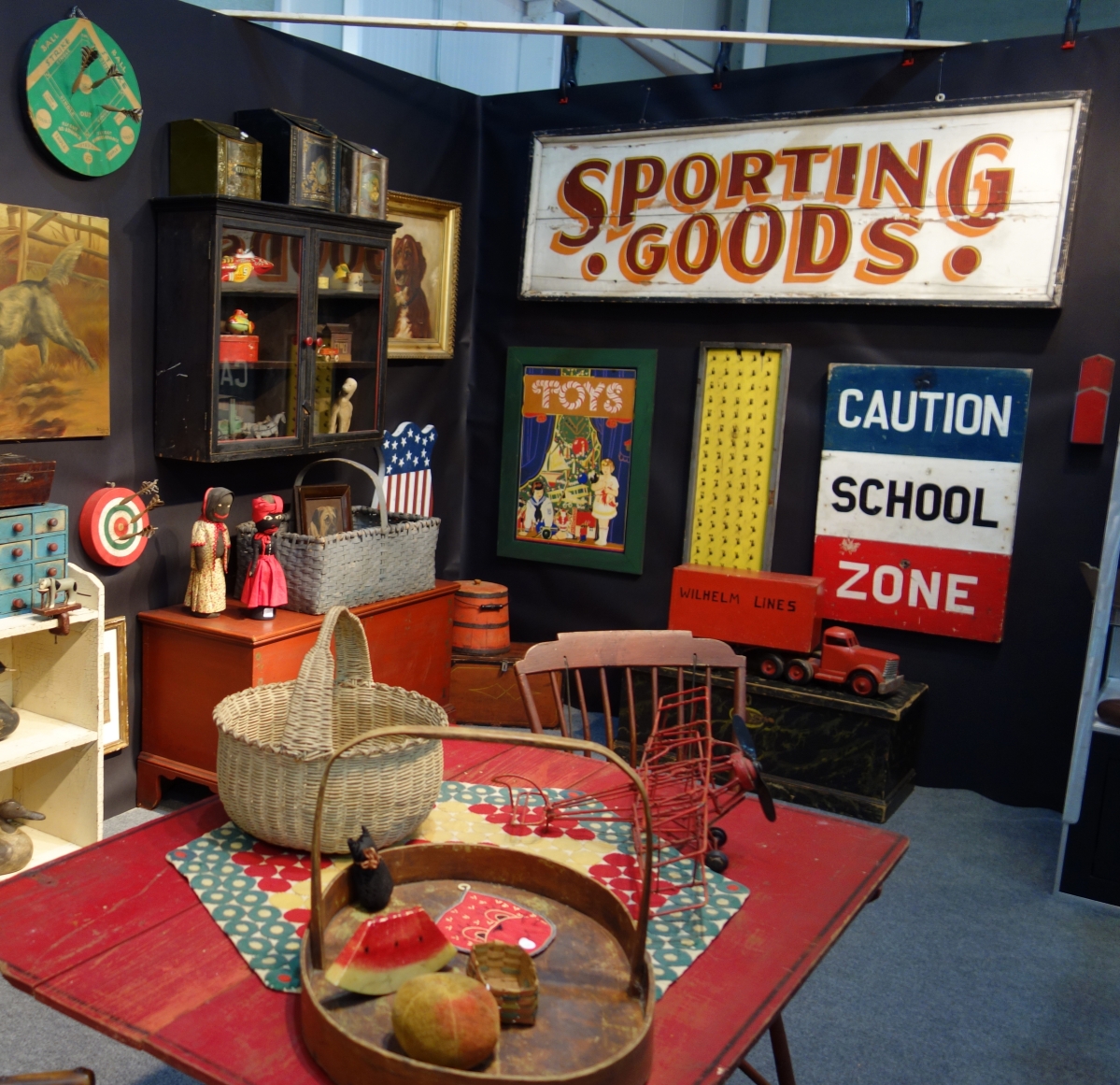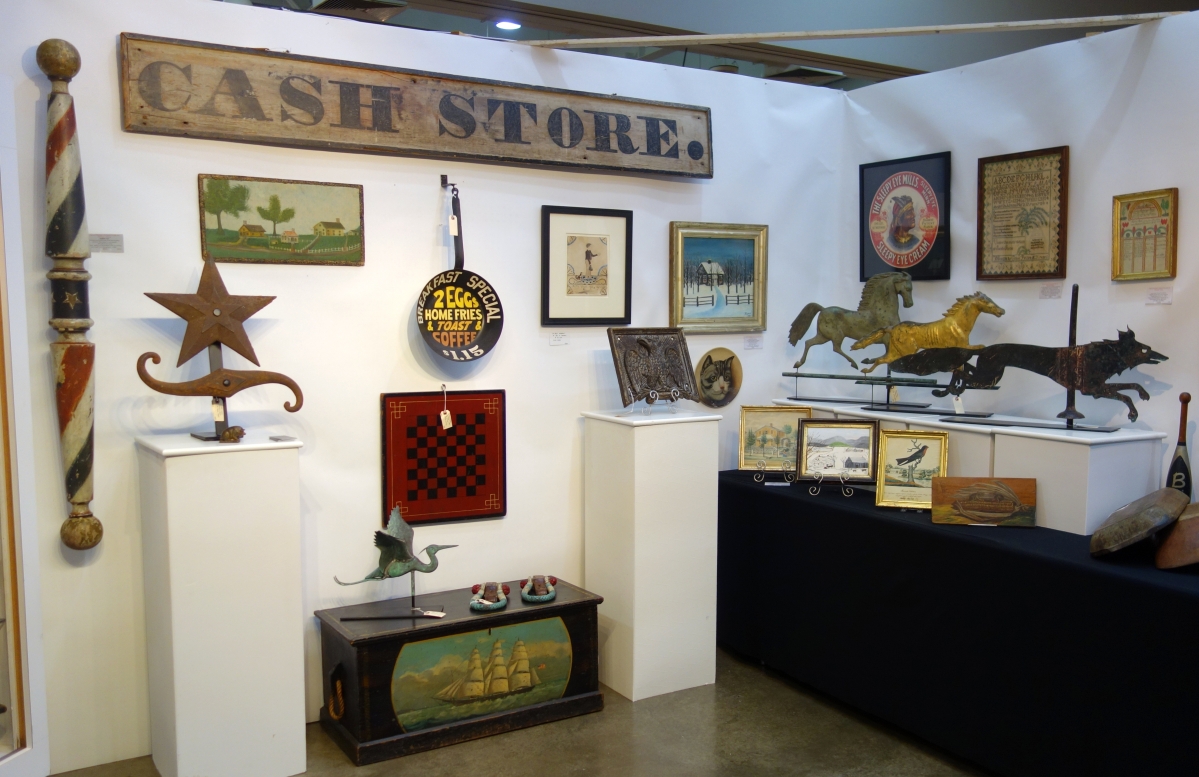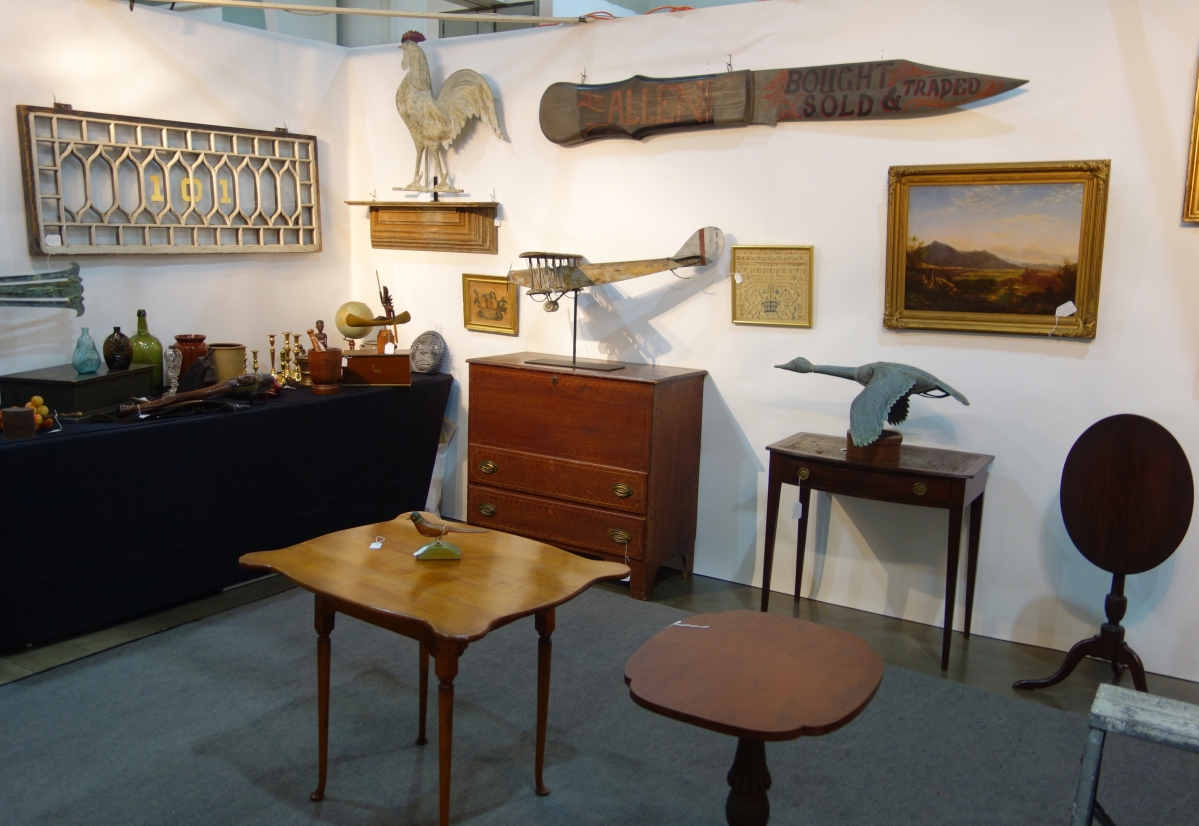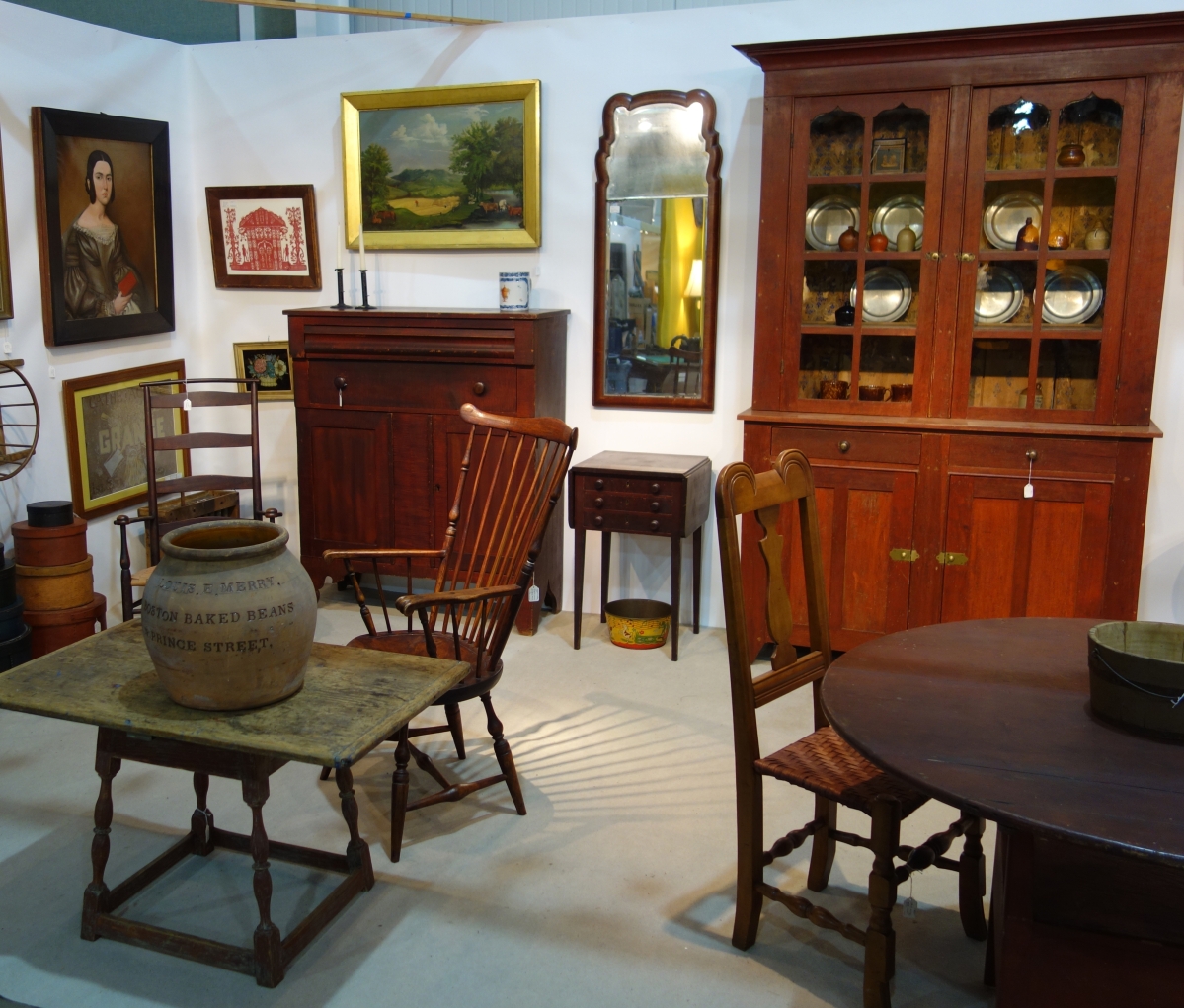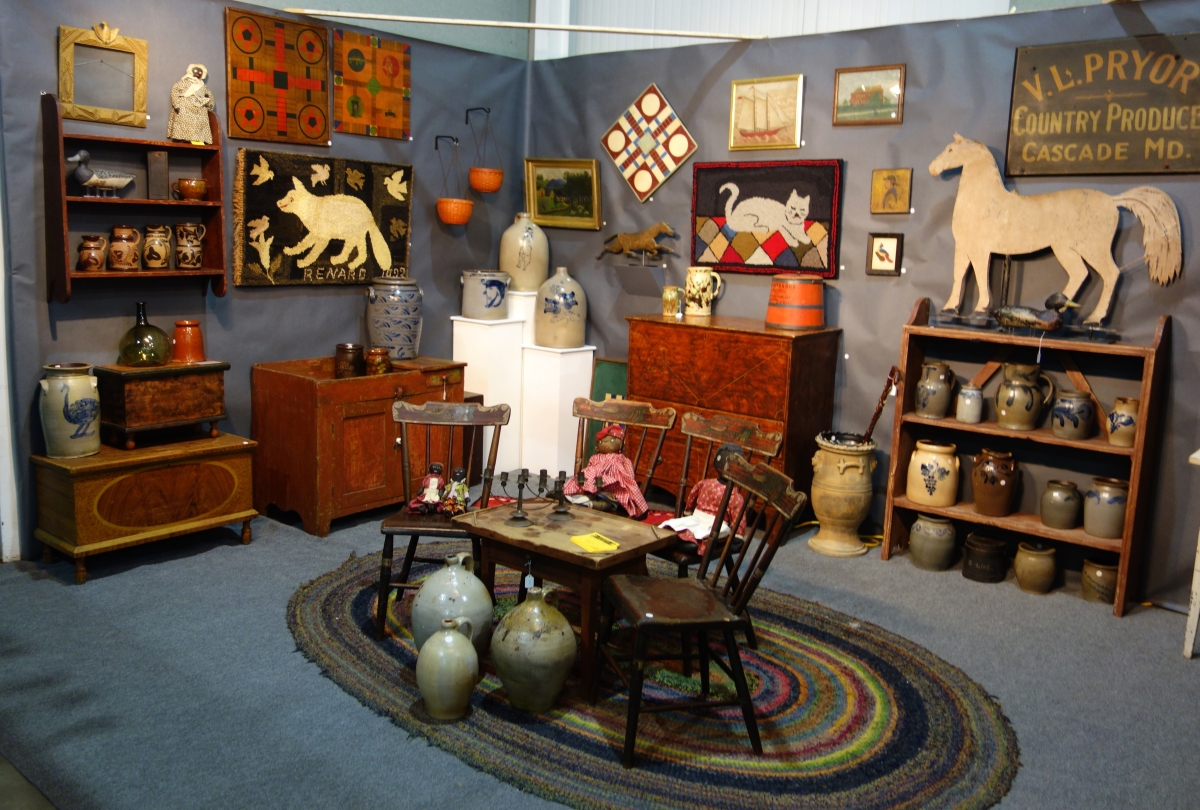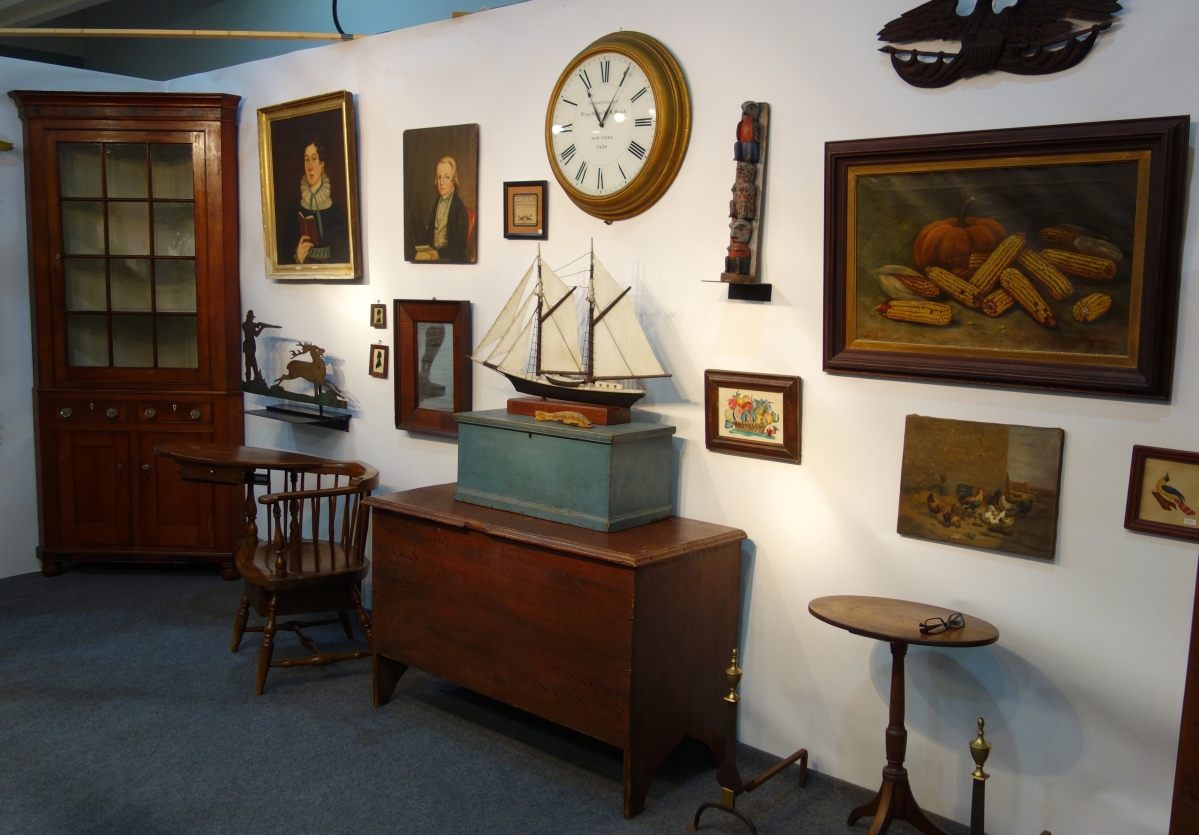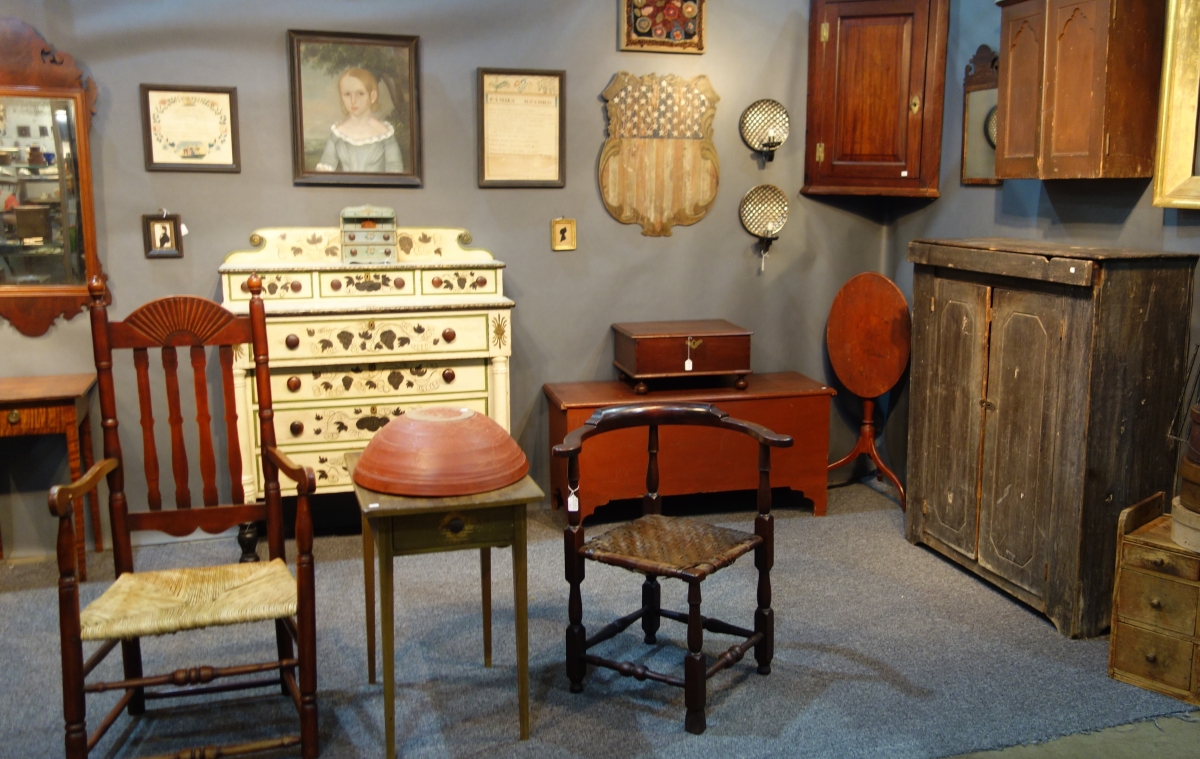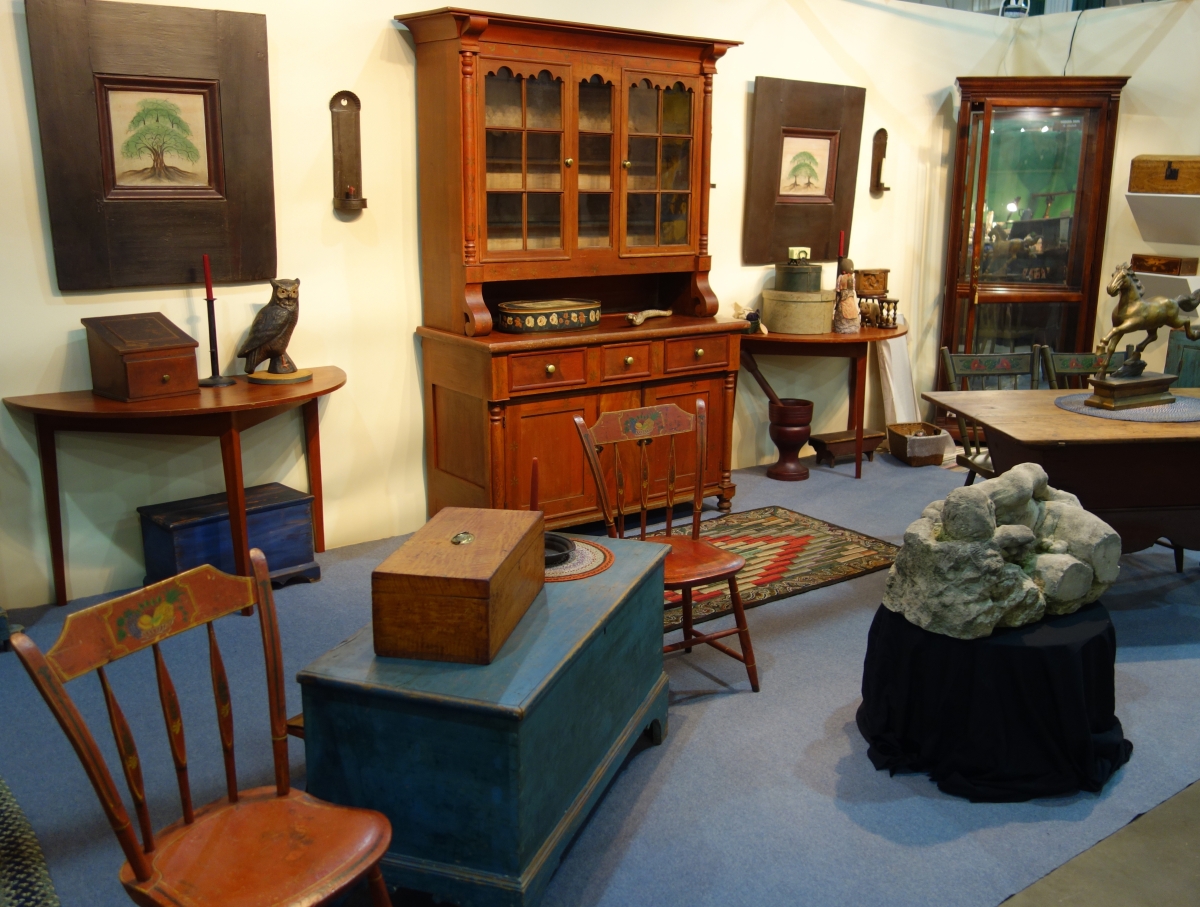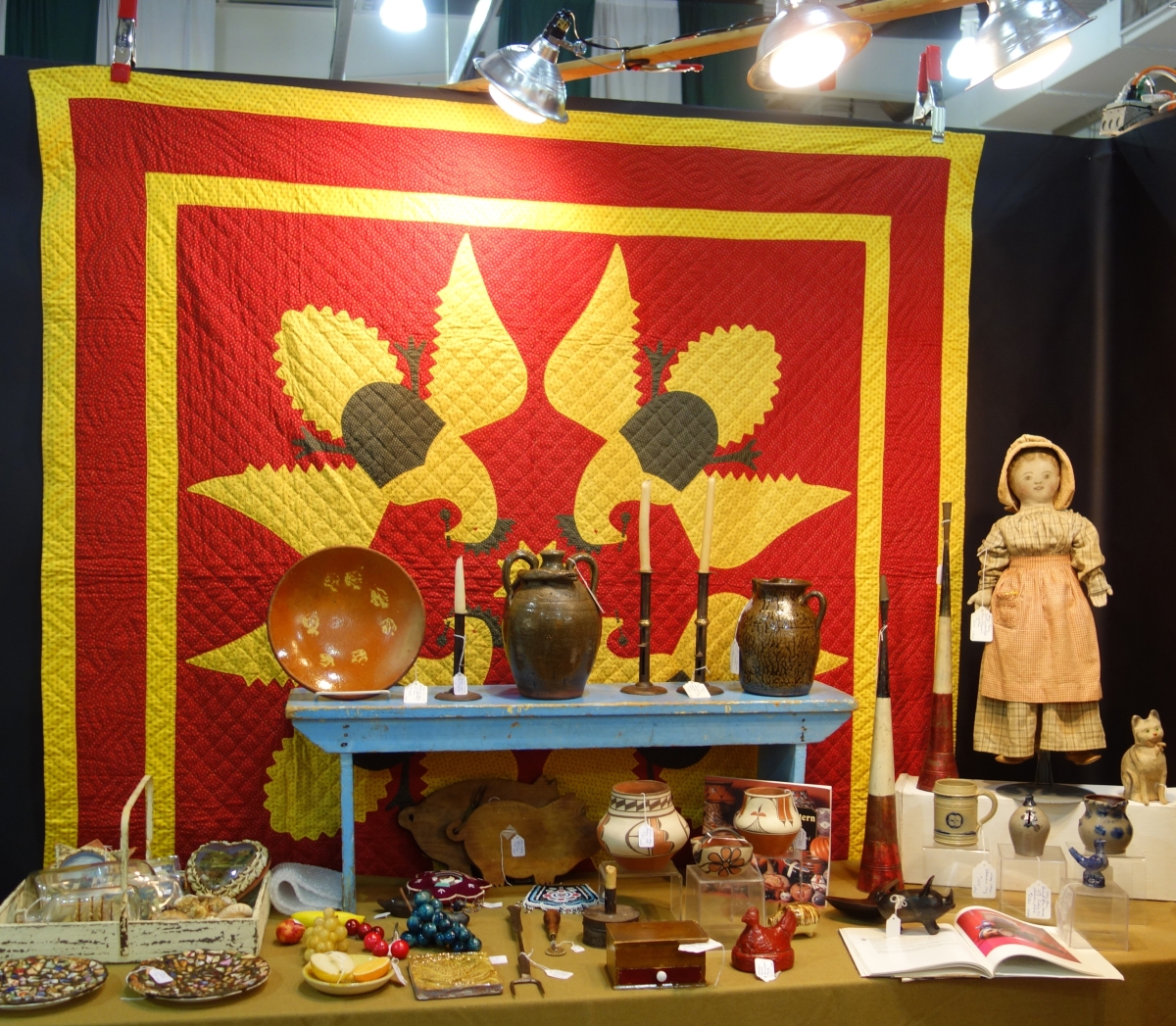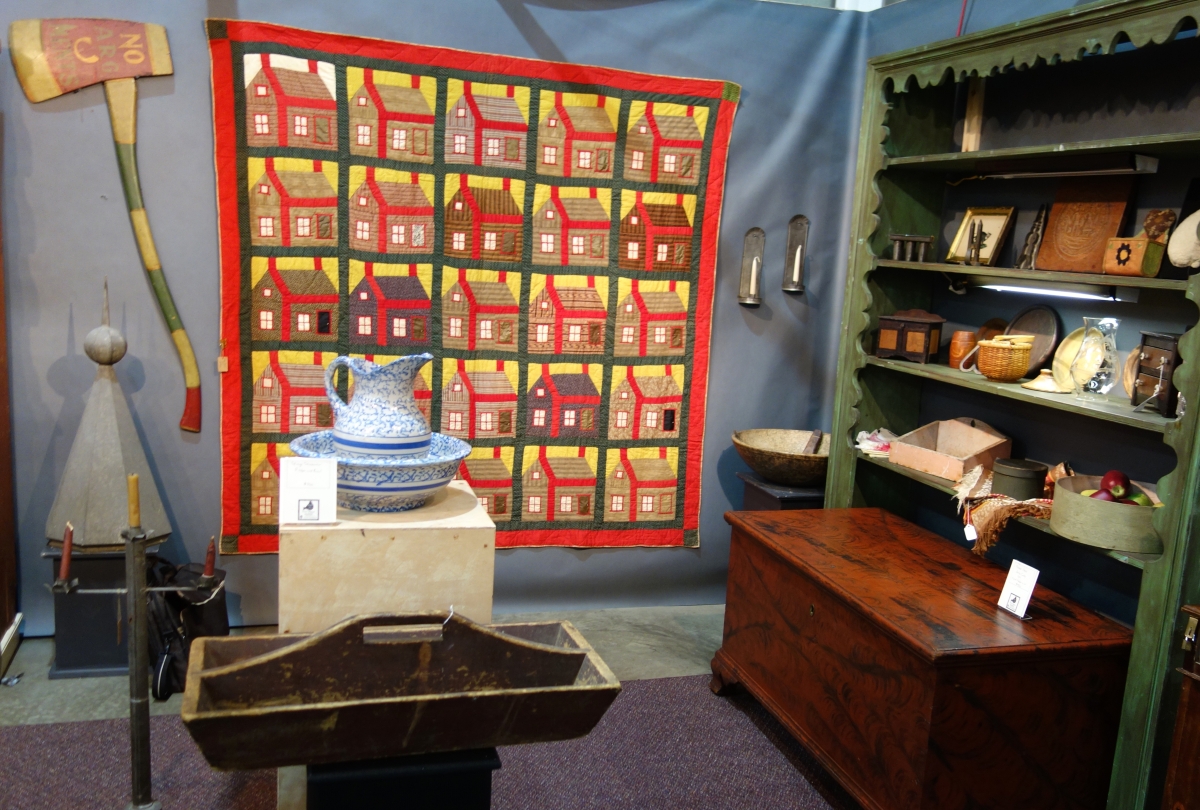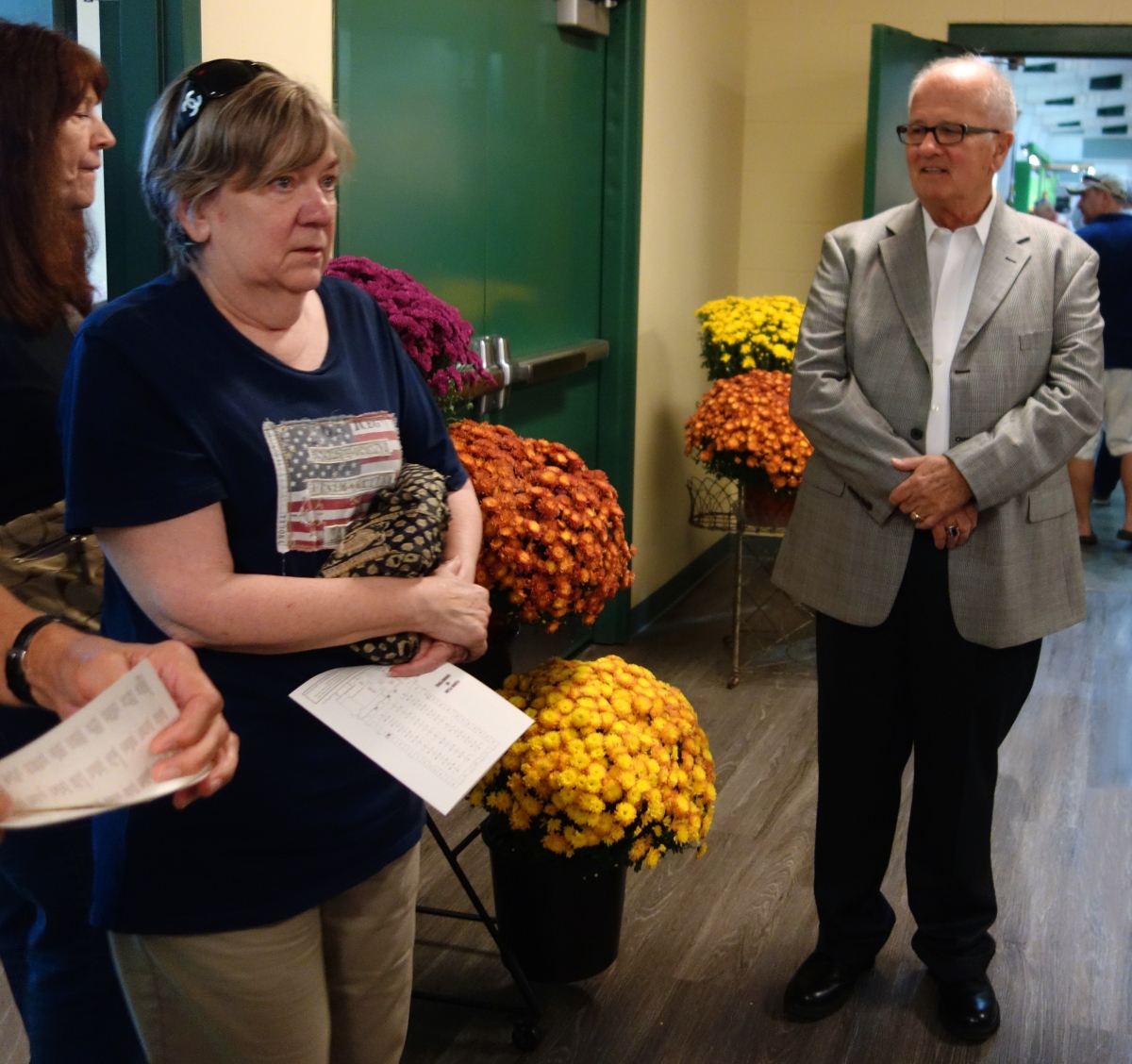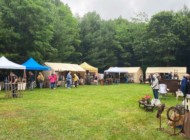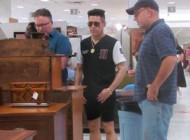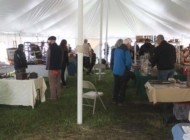Review and Photos by R. Scudder Smith
YORK, PENN. – “We had a great opening day on Friday, possibly a record-breaker, but both Saturday and Sunday were off and I don’t understand why,” Melvin “Butch” Arion said. He added that “I received nothing but positive compliments about how the show looked, not only from the visitors but also from the dealers in the show.”
The York Fairgrounds hosted its annual fall event just prior to the antiques show, causing a short time on Wednesday for the dealers to begin setup. In fact, workers were taking down the last tent on the grounds on Thursday morning, while the dealers were busy with a full day of setup. This semi-annual show, number 169, did look fine and the dealers made it happen with interesting objects and well-designed booths.
Due to several conflicts for dealers who had hoped to be at the show, six new dealers were in place, and “we hope that those who could not make it this time will be with us at the next show on February 2-4,” Butch said. He also mentioned that he has a good waiting list of dealers who would like to join the show.
The first booth off the lobby of Memorial Hall East was Arborfield Americana Antiques, St Louis, Mo., offering a New England country sofa, possibly Maine, dating circa 1810-30 and measuring 69 inches wide; and at the front of the booth was a Pennsylvania bench table in pine, with a two-board scrubbed top and some paint remaining on the base. It dated circa 1840, and over the table hung a small wrought iron chandelier.
Greg K. Kramer & Co. held down its usual spot right inside the main exhibition space, and it was filled to the brim with sculpture, wood carvings and many pieces of furniture, including a Pennsylvania two-part Dutch cupboard that was filled to capacity with many shapes of redware, including slip-decorated large and small plates, pitchers, jugs, cups, jars and bowls. It almost made one wonder if the cupboard was there to be sold or primarily a place to show pottery. Another Pennsylvania piece was a dough tray table with Sheraton legs, stretcher base, in old red and dating from the Nineteenth Century. Late afternoon Greg drove home to Robisonia, reportedly to not only sleep at home but also to bring more things in the next day to further fill out his booth, as if it needed more.
Part-way down the first left row was home to Dennis Raleigh of Wiscasset, Maine, with his booth of folk art displayed in a glass showcase, on the walls and on a table where two horses and a fox appeared to be racing across the tabletop. The weathervanes took the shape of a full-bodied Black Hawk, in the middle a Golds mith’s Maid, also full-copper body, and leading the pack was a cast iron fox, a silhouette dating circa 1920. Standing alone on a pedestal was a handsome eagle, possibly once decoration for a post office.
Kelly Kinzle, with a large booth not too far away from his shop in nearby New Oxford, Penn., offered a New England drop front desk in curly maple, circa 1790, and shown on a small table was a horse-drawn carriage with an Amish driver and two Amish passengers seated. The horse was white and the carriage had bright yellow wheels. A Chippendale Irish table, 1770, oval in form, had two leaves and ball and claw feet, and a bench from Lancaster County, Pennsylvania, circa 1825, had a grain-painted seat and paint-decorated spindles and rail across the back.
Samuel Herrup of Sheffield, Mass., is well known for his selection of redware, and he showed a fine collection, including a North Shore, Massachusetts, pitcher measuring 8¼ inches high, a piece probably made by the Osborne family, Peabody/Danvers, circa 1780-1810. A one-drawer stand with two-board top, cherry frame and legs, retaining the original knob, circa 1810-20 was of New England origin. It is rare that Sam does not offer a weathervane, and this time out he showed a choice horse and sulky with an original yellow surface on the horse.
“That quilt was never washed; you can still see the glaze on the fabric,” Richard “Smitty” Axtell said as he pointed out a fine schoolhouse quilt hung on the back wall of the booth. The buildings were enclosed in a series of squares in bright red fabric. The Deposit, N.Y., dealer also pointed out a grain-painted, six-board chest from Berks County, Pennsylvania, complete with a till, original strap hinges, and pasted to the inside of the lid was a fraktur for the Sayer family, dated 1783, the original owners of the chest. A six-foot-long wooden axe, circa 1840, was from a lodge and lettered reading “No Argument.” It was in the original paint and dates circa 1840. A small stepback cupboard retained its original red surface and came from a home in Springfield Center, N.Y.
It seemed obvious that Stephen-Douglas of Rockingham, Vt., would get the poultry award this year with its rooster display, including a plump bird of carved wood, dark red painted with sharp comb, perched on a small country table with one drawer and a one-board top, and a white painted rooster nearby, sitting on a paint-decorated six-board blanket chest. A cast iron table, perfect for use either inside or outside under a covered patio, was painted yellow, and the tray top was painted with a still life of fruit. Shown on the top of a six-board chest was a stack of five graduated wood carved and painted books.
A six-foot-long harvest table, circa 1825, red painted with two drop leaves, was at the front of the booth of Joseph Lodge, Lederach, Penn., the perfect place to also display a large ram weathervane, full-bodied copper, circa 1890. This vane had a textured body and horns that were tightly turned. Stacked at the front of the booth, far left, were nine oval Shaker boxes, late Nineteenth Century, in the original surface.
John H. Rogers, The Butter Stamp Man from Elkins, N.H., cut back a bit this time, offering a good selection of the prints, but not shelf after shelf as he has done in the past. This time he had a nice selection of redware pottery in one set of shelves, and three large pieces, two plates and one charger, all with slip decoration, displayed on a Nineteenth Century pine hutch table. Among the wood-carved paddles was an Indian effigy with horse head handle.
A large red, white and blue shield, an arrangement of stars over stripes, all on canvas, took up most of one wall in the booth of Jewett-Berdan of Newcastle, Maine. On the opposite wall a 4½-foot-high cutout of a colorful ice cream cone, priced at 5 cents, grabbed your eye, as did an early sign offering “Fresh Vegetables.” The back wall of the booth held a number of things, including two weathervanes, one a wooden deer in paint with tin antlers, small size, and a large sheet metal Indian with bow and arrow, remains of some paint, and two small dogs at the Indian’s feet.
James Grievo of Stockton, N.J., had an early trade sign, oval in shape, advertising “German American Co. Cotton Blankets, mfg. and finished by Cottonwool Process.” A large hooked rug depicted a row of three flowers, surrounded by a colorful wiggle border, and a corner hanging cupboard had one raised panel door. Tucked away in the corner of the booth was a cast iron pair of pine tree andirons.
Located not far from the show in Manheim, Penn., is Steven Still Antiques, who filled a large booth at the front of the show with folk art, furniture and pictures, including a Lebanon County blanket chest, all original paint decoration, circa 1830; a Mahantonga decorated slide-lid box, circa 1820-30, and a wall-mounted barber pole in the original red, white and blue paint, with a carved ball on each end. A large cupboard with three shelves in the top section, all filled with a collection of slip-decorated redware plates, over three short drawers and two paneled doors below.
A large Pennsylvania pine and walnut harvest table, circa 1840, was at the front of the booth of Steve Smoot Antiques & Navajo Textiles, Lancaster, Penn., and covered with a collection of Indian baskets of many different shapes, sizes and woven designs. A school of decorated, wooden fish decoys was offered, and a collection of 13 cast iron mechanical banks, including a short sleeve Dinah, a Punch & Judy, William Tell and Trick Pony filled a wall shelf on the back wall of the booth.
A fancy tin jewelry sign, black and gold painted with Roman numerals, hung close to a showcase containing a collection of jewelry in the booth of Pat and Rich Garthoeffner of Lititz, Penn. They also showed a large slide-lid box in the original blue painted surface, a hooked rug depicting a peaceful scene with a farmhouse and some trees, and a painting of a compote of fruit against a chrome yellow background, measuring 20 by 20 inches, dated 1906, by J.J. Raymond. Displayed in a row were three mortars and pestles, each in a different paint color, blue, red and yellow.
Other Lititz dealers, Robert Snyder and Judy Wilson, offered a hooked rug with Welcome across the center, and a grouping of four clown roly-poly figures by Schoenhut, all of a different size. A grove of bottle brush trees filled one corner of the case, varying in height, and Bob mentioned that “these are a favorite of Judy’s and at one time she had well over 50 of them in her collection.”
Jon Chaski Antiques of Lewes, Del., hung an early trade sign for “Conrad Woemer, Shoe & Boot Maker,” illustrated with four different styles of footwear, and a chest on chest, Connecticut or Rhode Island, circa 1780, was against the back wall. An interesting pie safe of small size, circa 1880, paint-decorated in grained yellow with red trim, retained its original screens on three sides.
James and Nancy Glazer of Bailey Island, Maine, offered a number of pieces of furniture, including a ribbon-back armchair, circa 1790, possibly by John Letchworth of Philadelphia, measuring 37ý inches high, and a set of six fancy, decorated chairs, New York, circa 1810, all original and in mint condition. A marquetry inlaid candlestand, American, was dated circa 1879 and the top measured 20 inches in diameter.
A circa 1830 paint-decorated chest, of Maine origin, came from the collection of the late Nan Gurley and was offered by Bill Kelly of Limington, Maine. He also showed a paint-decorated wooden shield, untouched condition, that dated 1870-80. The Antique Store in Wayne, Wayne, N.J., showed a large full-body bull weathervane, attributed to Cushing & White, circa 1880, and with a good yellow surface.
Tommy Thompson of Pembroke, N.H., bought himself a large straw hat with a pink ribbon, but found it too large to wear and thus offered it at the show. It hung right above an eight-piece doll’s bedroom set in yellow paint with red and black decoration. And for the collector of stone fruit, Tommy brought along five large bunches of white grapes.
Trumansburg, N.Y., dealer Ponzi’s Antiques brought some large pieces of furniture, including a cherry Queen Anne highboy with flat top and shell-carved center drawer in the lower section, slender Queen Anne legs and fluted feet. It was probably from Connecticut and dated from the Eighteenth Century. A Connecticut Chippendale carved cherry secretary-bookcase was from the school of Eliphalet Chapin of East Windsor or Hartford. It dated from the Eighteenth Century.
A dentist’s sign, triangular in shape with large gold letters on a black ground, hung on Tom Longacre’s side of the booth, and Bev Longacre filled the other section and was doing a brisk business selling ornaments from her Christmas collection. But back to Tom’s side. The Marlborough, N.H., dealer also offered a hooked rug depicting tumbling blocks, a long, narrow piece that could easily be used as a hallway runner, and at the front of the booth was a wood carved grasshopper weathervane with great detail and form. This vane was found in Massachusetts and dates circa 1900-30.
A large sheet iron horse standing on a long arrow was on top of a cupboard, making it the highest object in the booth of Newsom & Berdan of Hallowell, Maine, and Thomasville, Penn. Displayed on the back wall was a bright hooked rug with a dog in the center and a large red, blue and yellow pinwheel design in each corner. A Pennsylvania dry sink with zinc liner, paint-decorated, raised panel doors, dated from the first half of the Nineteenth Century.
Heller Washam Antiques from Portland, Maine, showed a Queen Anne maple tavern table, circa 1770, Massachusetts origin, with a one-board top, breadboard ends, measuring 54 by 33½ inches. A really neat piece was a model of an excursion boat, circa 1850-90, found in Mesburg, Mass., and of painted wood and wire. A smoke-decorated blanket chest, circa 1800, probably mid-Atlantic, was of poplar and pine.
A tap table of pine and birch was at the front of the booth of Pratt’s Antiques, Victor, N.Y., and on the back wall was a fire board from Eastern Shore, Maryland or Pennsylvania, circa 1840-50, showing a house, fence, people and trees, large and small.
Bright yellow mums were in a pair of cast iron urns with ornate handle, forming an entrance to the booth of Robert Conrad of Yeagertown, Penn. A dry sink in the original red, Pennsylvania origin, had a configuration of three drawers, and a yellow pine wood box on shoe feet was in old blue paint over the original red.
A large, round Lazy Susan table took up a large portion of the booth of Bruce Rigsby Antiques, Lancaster, Ky., and against the back wall was a small, green-painted stepback cupboard. A folk art table with inlay, Ohio, circa 1940-50, depicted birds, flowers and people on the top.
A painted model of a canal boat of Pennsylvania origin, circa 1950, was displayed on a grain-painted six-board chest with bracket feet in the booth of Keith and Diane Fryling, Green Lane, Penn. A display of pottery was housed in a yellow corner cupboard with a 12-light door.
Furniture filled the booth of James L. Price, Carlisle, Penn., including a Queen Anne walnut semi-tall chest with inlaid initials “RS,” three drawers over four, with bracket feet. It was dated circa 1775 and of Pennsylvania origin. A Chippendale walnut blanket chest, paint-decorated, was from the Rapho Township area of Lancaster County, dating circa 1791. Lettering on the chest read “This chest belongs to me, Magdalena Reider.”
For more information, www.theoriginalyorkantiquesshow.com or 302-875 5326.

